Radwin WINLINK Point to Point Wireless TX User Manual Airmux 104 fm
Radwin Ltd. Point to Point Wireless TX Airmux 104 fm
Radwin >
Users Manual
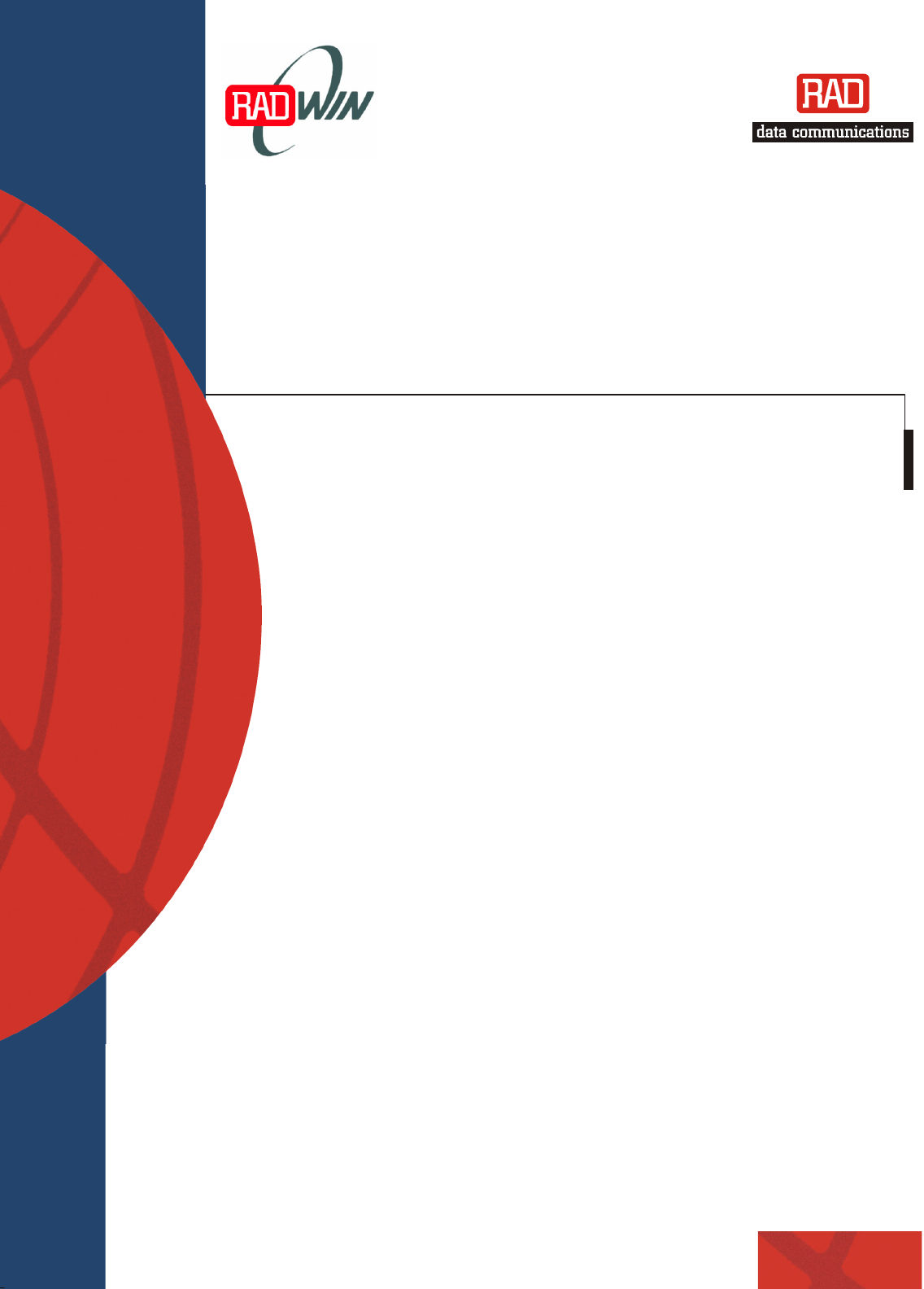
A
irMux-104
/
WinLink 582
Installation and Operation Manual
Point-to-Point Wireless
TDM/IP Multiplexer

AirMux-104/
WinLink 582
Point-to-Point Wireless TDM/IP Multiplexer
Installation and Operation Manual
Notice
This manual contains information that is proprietary to RAD Data Communications Ltd. ("RAD") and
RADWIN Ltd. (“RADWIN”). No part of this publication may be reproduced in any form whatsoever
without prior written approval by RAD Data Communications and RADWIN.
Right, title and interest, all information, copyrights, patents, know-how, trade secrets and other
intellectual property or other proprietary rights relating to this manual and to the AirMux-104/WinLink
582 and any software components contained therein are proprietary products of RAD and RADWIN
protected under international copyright law and shall be and remain solely with RAD and RADWIN.
AirMux-104/WinLink 582 is a registered trademark of RAD and RADWIN. No right, license, or interest
to such trademark is granted hereunder, and you agree that no such right, license, or interest shall be
asserted by you with respect to such trademark.
You shall not copy, reverse compile or reverse assemble all or any portion of the Manual or the
AirMux-104/WinLink 582. You are prohibited from, and shall not, directly or indirectly, develop,
market, distribute, license, or sell any product that supports substantially similar functionality as the
AirMux-104/WinLink 582, based on or derived in any way from the AirMux-104/WinLink 582. Your
undertaking in this paragraph shall survive the termination of this Agreement.
This Agreement is effective upon your opening of the AirMux-104/WinLink 582 package and shall
continue until terminated. RAD and RADWIN may terminate this Agreement upon the breach by you
of any term hereof. Upon such termination by RAD, you agree to return to RAD and RADWIN the
AirMux-104/WinLink 582 and all copies and portions thereof.
For further information contact RAD at the address below or contact your local distributor.
RAD Data Communications Ltd.
24 Raoul Wallenberg St.
Tel Aviv 69719 Israel
Tel: 972-3-6458181
Fax: 972-3-6498250
E-mail: rad@rad.co.il
RADWIN Ltd.
34 Habarzel St,
Tel-Aviv 69710, Israel
E-mail: radwin@radwin.com
© 2002–2003 RAD Data Communications Ltd., RADWIN Ltd. Publication No. 193-200-xx/03
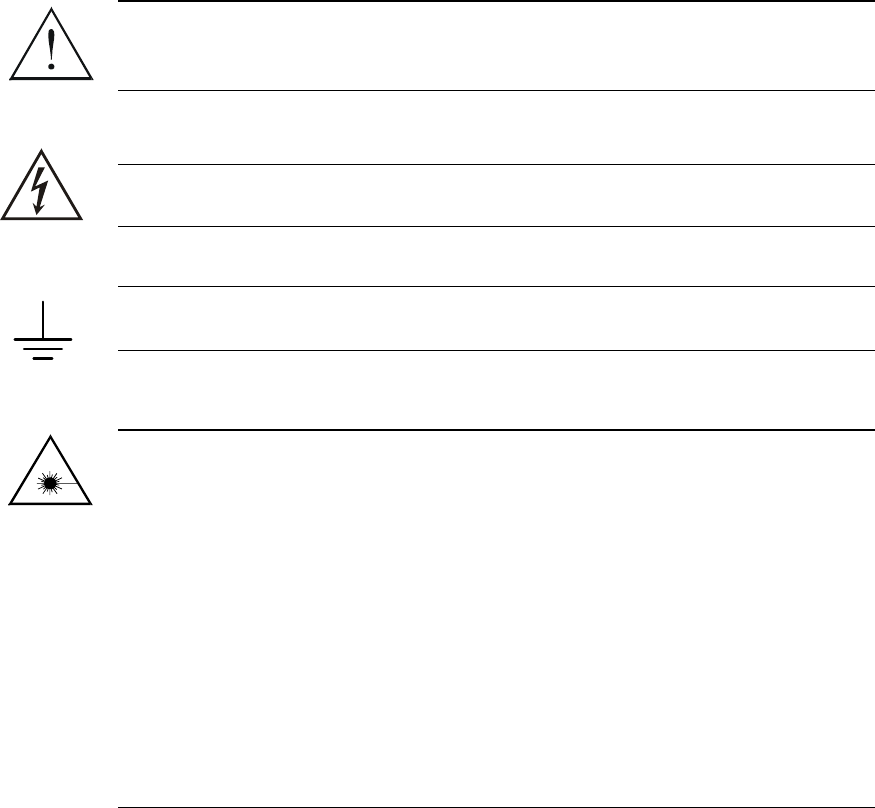
General Safety Instructions
The following instructions serve as a general guide for the safe installation and operation of
telecommunications products. Additional instructions, if applicable, are included inside the manual.
Safety Symbols
This symbol may appear on the equipment or in the text. It indicates
potential safety hazards regarding product operation or maintenance to
operator or service personnel.
Danger of electric shock! Avoid any contact with the marked surface while
the product is energized or connected to outdoor telecommunication lines.
.
Protective earth: the marked lug or terminal should be connected to the building
protective earth bus.
Some products may be equipped with a laser diode. In such cases, a label
with the laser class and other warnings as applicable will be attached near
the optical transmitter. The laser warning symbol may be also attached.
Please observe the following precautions:
• Before turning on the equipment, make sure that the fiber optic cable is
intact and is connected to the transmitter.
• Do not attempt to adjust the laser drive current.
• Do not use broken or unterminated fiber-optic cables/connectors or look
straight at the laser beam.
• The use of optical devices with the equipment will increase eye hazard.
• Use of controls, adjustments or performing procedures other than those
specified herein, may result in hazardous radiation exposure.
ATTENTION: The laser beam may be invisible!
Always observe standard safety precautions during installation, operation and maintenance of this
product. Only qualified and authorized service personnel should carry out adjustment, maintenance or
repairs to this product. No installation, adjustment, maintenance or repairs should be performed by
either the operator or the user.
Warning
Warning
Handling Energized Products
General Safety Practices
Do not touch or tamper with the power supply when the power cord is connected. Line voltages may
be present inside certain products even when the power switch (if installed) is in the OFF position or a
fuse is blown. For DC-powered products, although the voltages levels are usually not hazardous,
energy hazards may still exist.
Before working on equipment connected to power lines or telecommunication lines, remove jewelry
or any other metallic object that may come into contact with energized parts.
Unless otherwise specified, all products are intended to be grounded during normal use. Grounding is
provided by connecting the mains plug to a wall socket with a protective earth terminal. If an earth lug
is provided on the product, it should be connected to the protective earth at all times, by a wire with a
diameter of 18 AWG or wider. Rack-mounted equipment should be mounted only in earthed racks
and cabinets.
Always make the ground connection first and disconnect it last. Do not connect telecommunication
cables to ungrounded equipment. Make sure that all other cables are disconnected before
disconnecting the ground.
Connection of AC Mains
Make sure that the electrical installation complies with local codes.
Always connect the AC plug to a wall socket with a protective ground.
The maximum permissible current capability of the branch distribution circuit that supplies power to
the product is 16A. The circuit breaker in the building installation should have high breaking capacity
and must operate at short-circuit current exceeding 35A.
Always connect the power cord first to the equipment and then to the wall socket. If a power switch is
provided in the equipment, set it to the OFF position. If the power cord cannot be readily
disconnected in case of emergency, make sure that a readily accessible circuit breaker or emergency
switch is installed in the building installation.
Connection of DC Mains
Unless otherwise specified in the manual, the DC input to the equipment is floating in reference to the
ground. Any single pole can be externally grounded.
Due to the high current capability of DC mains systems, care should be taken when connecting the DC
supply to avoid short-circuits and fire hazards.
DC units should be installed in a restricted access area, i.e. an area where access is authorized only to
qualified service and maintenance personnel.
Make sure that the DC supply is electrically isolated from any AC source and that the installation
complies with the local codes.
The maximum permissible current capability of the branch distribution circuit that supplies power to
the product is 16A. The circuit breaker in the building installation should have high breaking capacity
and must operate at short-circuit current exceeding 35A.
Before connecting the DC supply wires, ensure that power is removed form the DC circuit. Locate the
circuit breaker of the panel board that services the equipment and switch it to the OFF position. When
connecting the DC supply wires, first connect the ground wire to the corresponding terminal, then the
positive pole and last the negative pole. Switch the circuit breaker back to the ON position.
A readily accessible disconnect device that is suitably rated and approved should be incorporated in
the building installation.

Installing the Radio Terminals (RTs)
The following safety measures apply when installing the radio terminals and masts.
• Mast / pole / towers should comply with local standards such as BS6651.
• Only trained professional installers should be used when installing or dismantling radio terminals
and masts. The installer is responsible for meeting all building and safety codes.
• Before installing a terminal, make sure it is disconnected from power.
• A safety belt and climbing harness must be used when installing the radio terminals on a mast or
tower.
• Masts of height 3 meters or more must be guyed according to required industry standards and be
lightning protected.
• If a radio terminal is to be mounted at a height of more than 4 meters above the roof, it is
recommended that a climbable tower be installed to give access to the equipment and to prevent
antenna movement during strong winds.
• When installing equipment, beware of overhead high-voltage power lines. Never install a mast
under power lines.
• The mast structure must be grounded.
• Do not stand in front of live radio terminal.
• The installer should configure the output power level of antennas, according to country regulations
and per antenna type.
• The antenna used for this transmitter must be installed to provide a separation distance of at least
20 cm from all persons and must not be co-located or operating in conjunction with any other
antenna or transmitter.
Outdoor units and antennas should be installed ONLY by experienced
installation professionals who are familiar with local building and safety
codes and, wherever applicable, are licensed by the appropriate government
regulatory authorities. Failure to do so may void the AirMux-104/WinLink 582
warranty and may expose the end user or the service provider to legal and
financial liabilities. RAD, RADWIN and their resellers or distributors are not
liable for injury, damage or violation of regulations associated with the
installation of outdoor units or antennas.
Protection Against Lightning Activity
Observe the following safety measures to protect personnel and equipment:
• All outdoor equipment must be attached to a properly grounded structure, and installed masts
must be grounded, in order to provide protection against lightening, surges and static buildup. In
addition, mast over 3 meters should have lightning protection rod. Failure to do so creates a safety
risk and will void the equipment warranty.
• Do not work on the system or connect or disconnect the cables prior to, or during, electrical storm
activity.
• In case of an electrical storm, do not touch any outdoor electrical equipment and get off the roof
as quickly as possible.
Warning
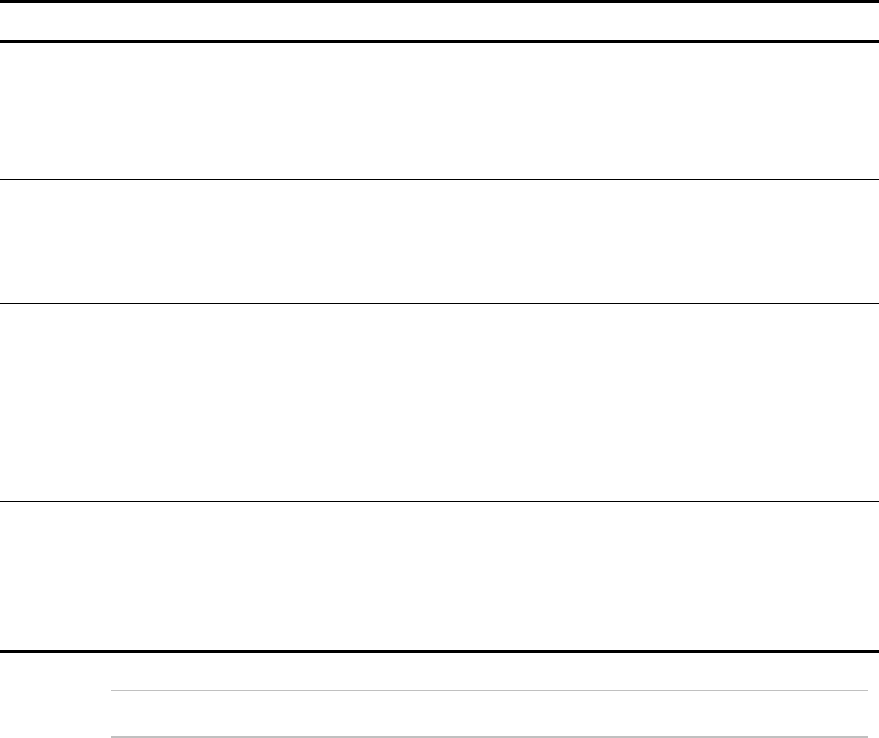
Connection of Data and Telecommunications Cables
Data and telecommunication interfaces are classified according to their safety status.
The following table lists the status of several standard interfaces. If the status of a given port differs from
the standard one, a notice will be given in the manual.
Ports Safety Status
V.11, V.28, V.35, V.36, RS-530,
X.21, 10 BaseT, 100 BaseT,
Unbalanced E1, E2, E3, STM, DS-2,
DS-3, S-Interface ISDN, Analog voice
E&M
SELV Safety Extra Low Voltage:
Ports which do not present a safety hazard. Usually
up to 30 VAC or 60 VDC.
xDSL (without feeding voltage),
Balanced E1, T1, Sub E1/T1
TNV-1 Telecommunication Network Voltage-1:
Ports whose normal operating voltage is within the
limits of SELV, on which overvoltages from
telecommunications networks are possible.
FXS (Foreign Exchange Subscriber) TNV-2 Telecommunication Network Voltage-2:
Ports whose normal operating voltage exceeds the
limits of SELV (usually up to 120 VDC or telephone
ringing voltages), on which overvoltages from
telecommunication networks are not possible. These
ports are not permitted to be directly connected to
external telephone and data lines.
FXO (Foreign Exchange Office), xDSL
(with feeding voltage), U-Interface
ISDN
TNV-3 Telecommunication Network Voltage-3:
Ports whose normal operating voltage exceeds the
limits of SELV (usually up to 120 VDC or telephone
ringing voltages), on which overvoltages from
telecommunication networks are possible.
The signals between the RT and RTCB are TNV-1.
Always connect a given port to a port of the same safety status. If in doubt, seek the assistance of a
qualified safety engineer.
Always make sure that the equipment is grounded before connecting telecommunication cables. Do
not disconnect the ground connection before disconnecting all telecommunications cables.
Some SELV and non-SELV circuits use the same connectors. Use caution when connecting cables.
Extra caution should be exercised during thunderstorms.
When using shielded or coaxial cables, verify that there is a good ground connection at both ends. The
earthing and bonding of the ground connections should comply with the local codes.
The telecommunication wiring in the building may be damaged or present a fire hazard in case of
contact between exposed external wires and the AC power lines. In order to reduce the risk, there are
restrictions on the diameter of wires in the telecom cables, between the equipment and the mating
connectors.
Note

To reduce the risk of fire, use only No. 26 AWG or larger telecommunication line cords.
Pour réduire les risques s’incendie, utiliser seulement des conducteurs de
télécommunications 26 AWG ou de section supérieure.
Some ports are suitable for connection to intra-building or non-exposed wiring or cabling only. In such
cases, a notice will be given in the installation instructions.
Do not attempt to tamper with any carrier-provided equipment or connection hardware.
Electromagnetic Compatibility (EMC)
The equipment is designed and approved to comply with the electromagnetic regulations of major
regulatory bodies. The following instructions may enhance the performance of the equipment and will
provide better protection against excessive emission and better immunity against disturbances.
A good earth connection is essential. When installing the equipment in a rack, make sure to remove all
traces of paint from the mounting points. Use suitable lock-washers and torque. If an external
grounding lug is provided, connect it to the earth bus using braided wire as short as possible.
The equipment is designed to comply with EMC requirements when connecting it with unshielded
twisted pair (UTP) cables. However, the use of shielded wires is always recommended, especially for
high-rate data. In some cases, when unshielded wires are used, ferrite cores should be installed on
certain cables. In such cases, special instructions are provided in the manual.
Disconnect all wires which are not in permanent use, such as cables used for one-time configuration.
The compliance of the equipment with the regulations for conducted emission on the data lines is
dependent on the cable quality. The emission is tested for UTP with 80 dB longitudinal conversion loss
(LCL).
Unless otherwise specified or described in the manual, TNV-1 and TNV-3 ports provide secondary
protection against surges on the data lines. Primary protectors should be provided in the building
installation.
The equipment is designed to provide adequate protection against electro-static discharge (ESD).
However, it is good working practice to use caution when connecting cables terminated with plastic
connectors (without a grounded metal hood, such as flat cables) to sensitive data lines. Before
connecting such cables, discharge yourself by touching earth ground or wear an ESD preventive wrist
strap.
FCC-15 User Information
This equipment has been tested and found to comply with the limits of the Class A digital device,
pursuant to Part 15 of the FCC rules. These limits are designed to provide reasonable protection
against harmful interference when the equipment is operated in a commercial environment. This
equipment generates, uses and can radiate radio frequency energy and, if not installed and used in
accordance with the Installation and Operation manual, may cause harmful interference to the radio
communications. Operation of this equipment in a residential area is likely to cause harmful
interference in which case the user will be required to correct the interference at his own expense.
Changes or modifications to this equipment not expressly approved by the party responsible for
compliance (RAD) could void the user’s authority to operate the equipment.
Caution
A
ttentio
n
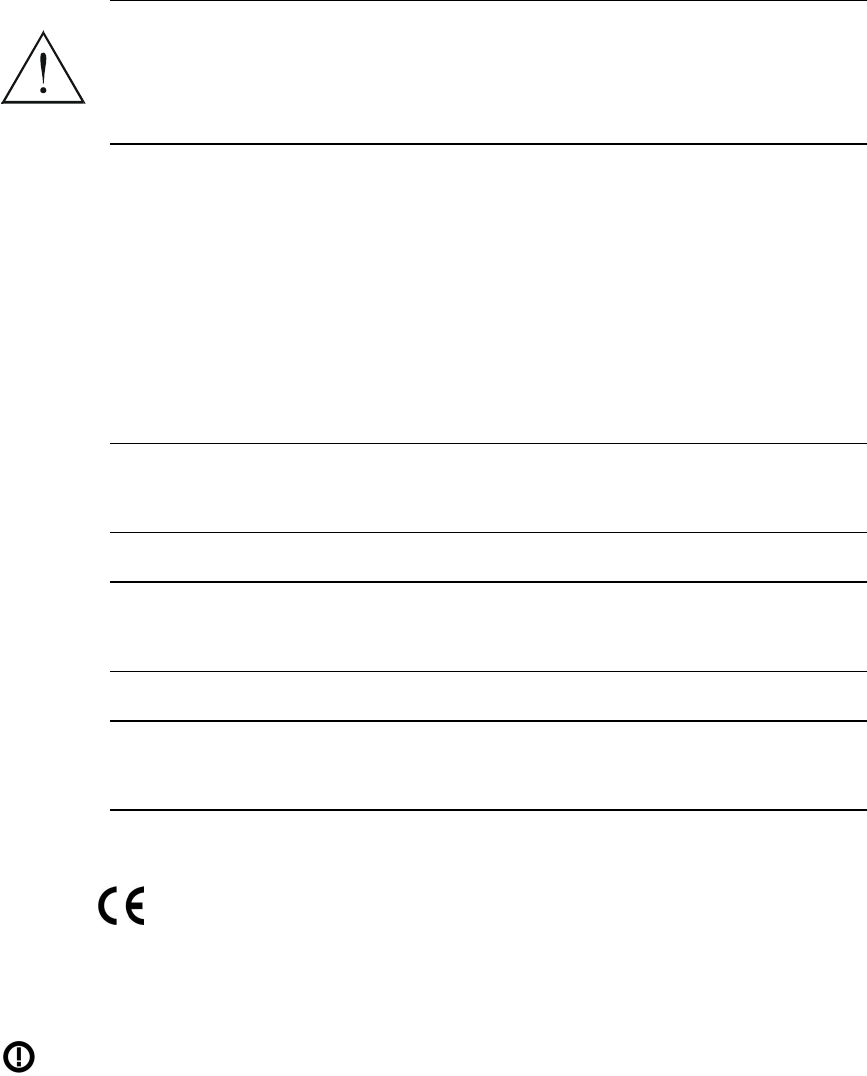
It is the responsibility of the installer to ensure that when using the outdoor
antenna kits in the United States (or where FCC rules apply), only those
antennas certified with the product are used. The use of any antenna other
than those certified with the product is expressly forbidden in accordance to
FCC rules CFR47 part 15.204.
Canadian Emission Requirements for the RTCB
This Class A digital apparatus meets all the requirements of the Canadian Interference-Causing
Equipment Regulation.
Cet appareil numérique de la classe A respecte toutes les exigences du Règlement sur le matériel
brouilleur du Canada.
Warning per EN 55022 (CISPR-22) for the RTCB
This is a class A product. In a domestic environment, this product may cause
radio interference, in which case the user will be required to take adequate
measures.
Cet appareil est un appareil de Classe A. Dans un environnement résidentiel, cet
appareil peut provoquer des brouillages radioélectriques. Dans ces cas, il peut
être demandé à l’utilisateur de prendre les mesures appropriées.
Dieses ist ein Gerät der Funkstörgrenzwertklasse A. In Wohnbereichen können
bei Betrieb dieses Gerätes Rundfunkströrungen auftreten, in welchen Fällen der
Benutzer für entsprechende Gegenmaßnahmen verantwortlich ist.
Statement according to Directive 1999/5/EC
Hereby, RAD Data Communications Ltd. and RADWIN Ltd. declare that the AirMux-104/WinLink 582
system is in compliance with the essential requirements and other relevant provisions of
Directive 1995/5/EC.
The alert sign on the AirMux-104/WinLink 582 indicates that the frequency band that is being
used by the equipment is not harmonized within the EU and/or the potential restrictions on its
use are applicable in one or more EU member states.
Warning
A
vertissement
A
chtung
Warning

Installing AirMux-104 Units 1
Quick Start Guide
Installation of AirMux-104 should be carried out only by an experienced
technician. If you are familiar with AirMux-104, use this guide to prepare the units
for operation.
1. Installing AirMux-104 Units
Performing Initial Setup
To perform initial setup:
1. Install and run the AirMux-104 management software on the network
management station.
2. Prepare the 2m RT-to-RTCB configuration cable for initial setup.
3. Connect the first RTCB to its RT using the 2m configuration cable.
4. Power up the first RTCB.
5. Connect management station to the first RTCB.
6. Perform initial configuration of AirMux-104 and download the new parameters
to the first unit.
7. Disconnect the configuration cable from the first RTSB and its RT.
8. Connect the second RTCB to its RT using the 2m configuration cable.
9. Connect the network management station to the second RTCB.
10. Download the new parameters to the second AirMux-104.
Performing Outdoor Installation
To install the RT:
1. Route the RT cable from the RT location (on the roof) to the RTCB location
(inside the building).
2. Attach the RT unit to the mast, using the two strap clamps.
3. Use the RT cable to connect the RTCB to the RT.
4. Secure the RT and ground cables to the mast or brackets using provided
UV-rated cable ties.
5. Repeat the procedure at the remote site.
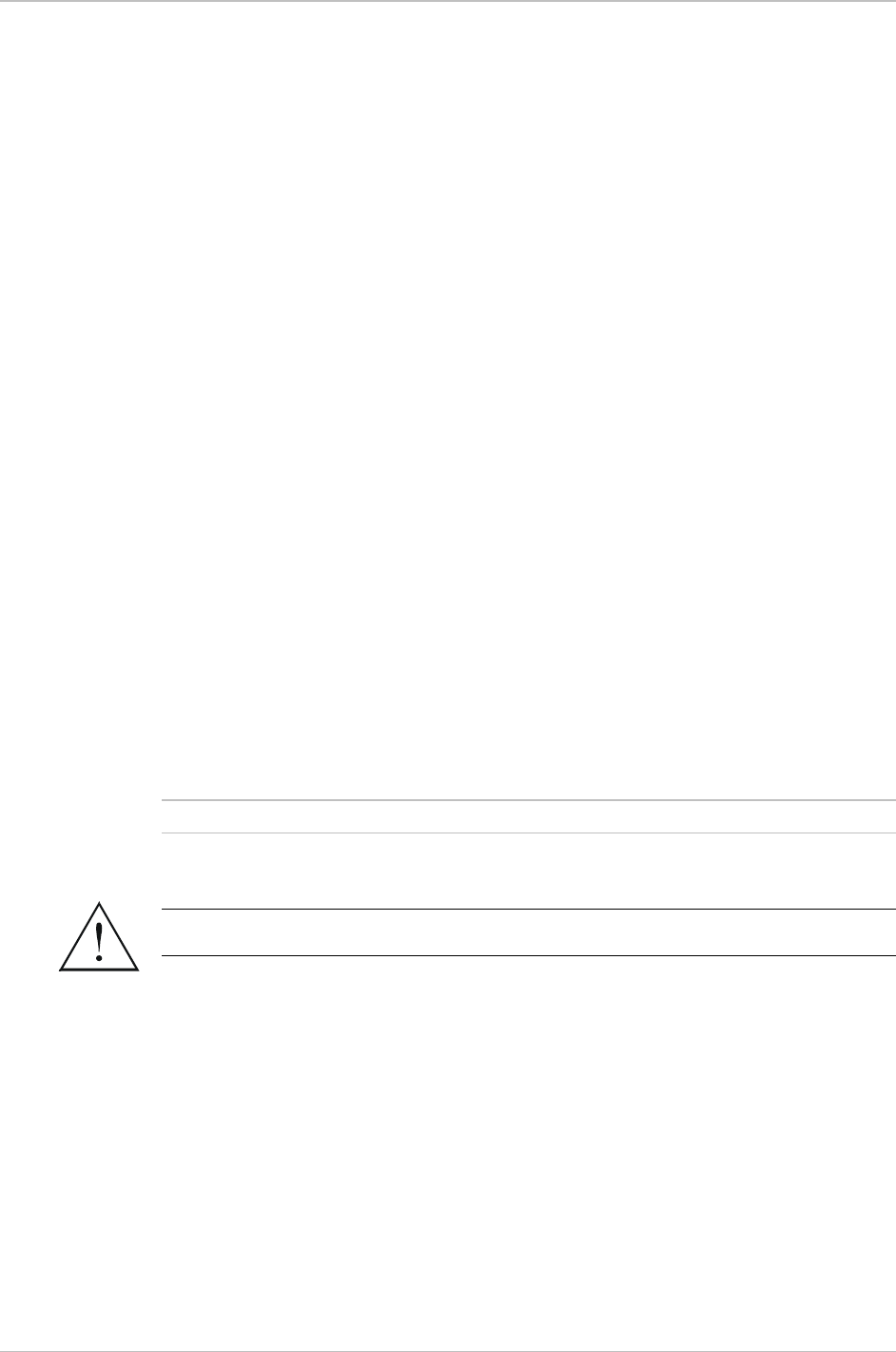
Quick Start Guide AirMux-104 Installation and Operation Manual
2 Installing AirMux-104 Units
To align the RTs:
1. Connect power to the RTCBs.
2. Turn the local RT in the direction of the remote RT.
3. At the remote site, align the RT to face the local RT. (Align visually or by using
a map and a compass). Use the RSS/SNR, LINK and STATUS LEDs at the base
of the RT for the link quality indication:
RTs are not aligned:
Triple RSS/SNR LED is blinking
LINK LED is OFF
STATUS LED is blinking slowly.
RTs are aligned:
Triple RSS/SNR LED is blinking or lit steadily
LINK LEDs is lit steadily
STATUS LED is blinking rapidly.
4. Repeat steps 3 to 4 for the local RT to complete the installation procedure.
5. Make sure that the management station is properly connected to the local
RTCB, and the AirMux Manager application is running.
6. In the Main menu, click Monitor.
7. Verify the radio signal strength (RSS) and sound-to-noise ratio (SNR) in the
Main menu.
RSS is better than -88 dBm
SNR must be at least 9 dB.
Try achieving the best possible RSS and SNR values.
8. View these parameters for about 15 min. to verify stability. After achieving the
best RSS and SNR levels, permanently attach the remote RTs to the mast/wall.
Do not stand in front of live radio terminal.
Performing Indoor Installation
To connect user equipment to the RTCB:
1. Connect user mux or PBX to the RTCB rear panel RJ-45 port designated E1.
2. Connect user hub/router or any other compatible device to the RTCB rear
panel RJ-45 port designated 10/100 LAN.
Warning
Note
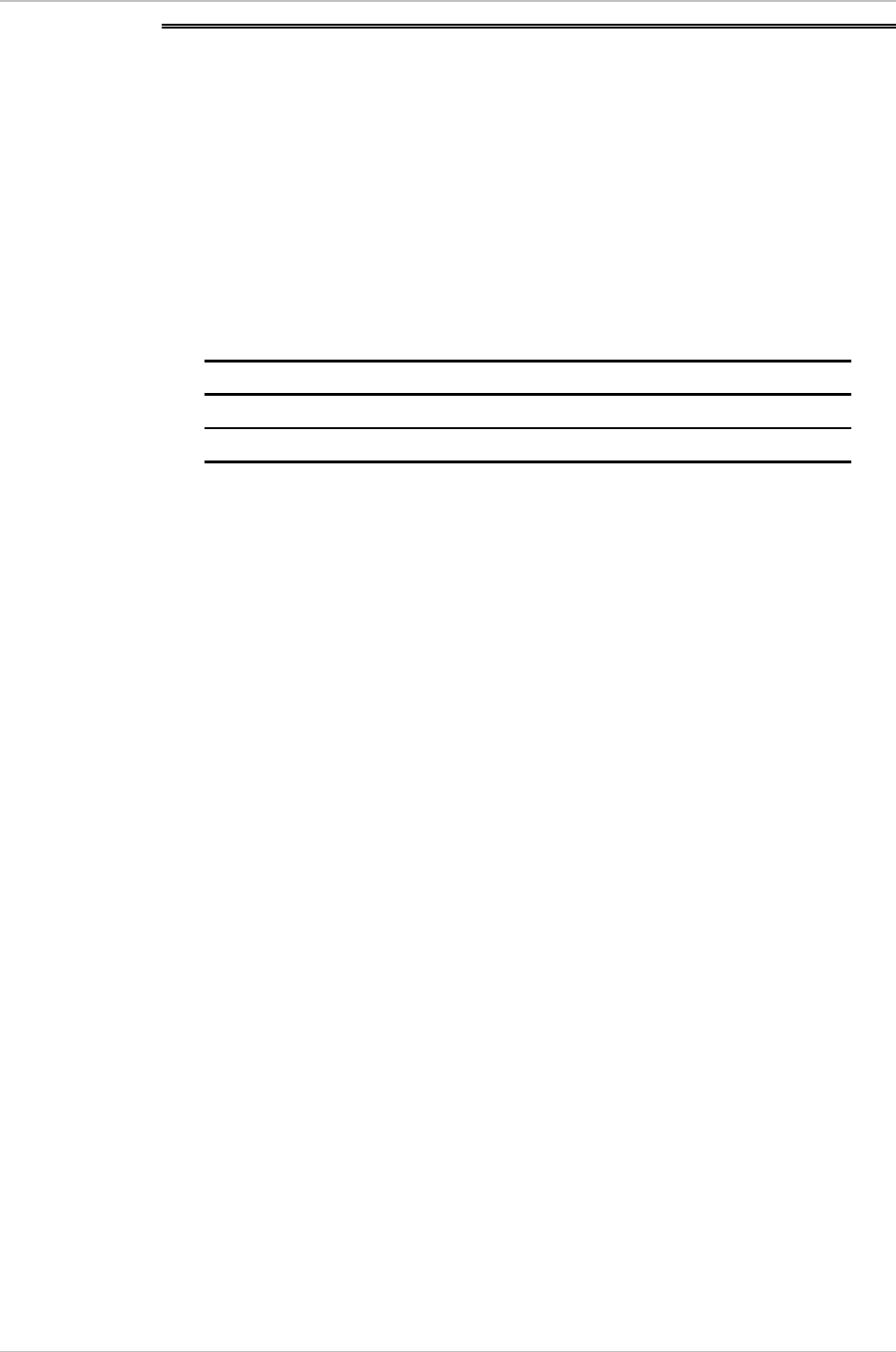
AirMux-104 Installation and Operation Manual Quick Start Guide
Operating AirMux-104 3
2. Operating AirMux-104
AirMux-104 requires no operator attention once installed, with the exception of
occasional monitoring of front panel indicators and statistics data. Intervention is
only required when AirMux-104 must be configured to its operational
requirements, or diagnostic tests are performed.
Normal Indications
Upon turning on AirMux-104, the PWR LED in the front panel lights to indicate
that AirMux-104 is on. The table below shows the correct status of the indicators a
few seconds after power-up.
Indicator Status
PWR ON
RTCB ON

Quick Start Guide AirMux-104 Installation and Operation Manual
4 Operating AirMux-104

AirMux-104 Installation and Operation Manual i
Contents
Chapter 1. Introduction
1.1 Overview..................................................................................................................... 1-1
Application ...........................................................................................................................1-1
Features................................................................................................................................1-1
1.2 Physical Description..................................................................................................... 1-3
1.3 Technical Specifications............................................................................................... 1-4
Chapter 2. Initial Setup
2.1 Introduction................................................................................................................. 2-1
2.2 AirMux-104 System ..................................................................................................... 2-2
2.3 Installing AirMux-104 Management Software............................................................... 2-2
2.4 Performing Initial Setup of AirMux-104........................................................................ 2-2
Configuring General Parameters............................................................................................2-4
Configuring Service Parameters .............................................................................................2-6
Downloading Configuration Parameters ................................................................................2-8
Chapter 3. Installation and Setup
3.1 Site Requirements and Prerequisites ............................................................................ 3-1
3.2 Package Contents ........................................................................................................ 3-1
3.3 Installation and Setup .................................................................................................. 3-2
Outdoor Installation..............................................................................................................3-3
Indoor Installation.................................................................................................................3-8
Chapter 4. Operation
4.1 Front Panel Indicators .................................................................................................. 4-1
4.2 Operating AirMux-104 ................................................................................................ 4-2
Turning On AirMux-104 .......................................................................................................4-2
Normal Indications ...............................................................................................................4-2
Turning Off AirMux-104 .......................................................................................................4-2
4.3 Managing AirMux-104 ................................................................................................. 4-3
Changing Configuration Parameters ......................................................................................4-4
Displaying AirMux-104 Inventory..........................................................................................4-7
Chapter 5. Diagnostics and Troubleshooting
5.1 Error Detection............................................................................................................ 5-1
Power-Up Self-Test...............................................................................................................5-1
Alarms ..................................................................................................................................5-1
5.2 Collecting Statistics ...................................................................................................... 5-3
5.3 Running Diagnostic Loopbacks .................................................................................... 5-4
Local External Loopback .......................................................................................................5-5
Remote Internal Loopback....................................................................................................5-5
Remote External Loopback ...................................................................................................5-6
Local Internal Loopback........................................................................................................5-6
Appendix A. Wiring Specifications
Appendix B. Mast and Wall Installation

Table of Contents
ii AirMux-104 Installation and Operation Manual
List of Figures
1-1. Typical Application................................................................................................................ 1-1
1-2. AirMux-104 Unit ................................................................................................................... 1-3
2-1. AirMux Manager Main Menu ................................................................................................ 2-3
2-2. Confirmation Message for Communication Preference Change.............................................. 2-4
2-3. Communication Preferences Dialog Box................................................................................ 2-4
2-4. General Parameters Dialog Box .............................................................................................2-5
2-5. Service Parameters Dialog Box .............................................................................................. 2-6
2-6. IP Parameters ........................................................................................................................ 2-8
2-7. Download Data Dialog Box................................................................................................... 2-9
2-8. Installation Completed Successfully Message ......................................................................... 2-9
3-1. Typical Installation (for Reference and Illustration only) ......................................................... 3-2
3-2. Rear Panel............................................................................................................................. 3-3
3-3. RT LEDs ................................................................................................................................ 3-4
4-1. Front Panel............................................................................................................................ 4-1
4-2. Main Menu, Wireless Link is Active ....................................................................................... 4-3
4-3. Communication Preferences Dialog Box................................................................................ 4-5
4-4. Configure Dialog Box ............................................................................................................ 4-6
4-5. AirMux-104 Inventory ........................................................................................................... 4-7
5-1. AirMux-104 Alarms and Status Indications............................................................................. 5-2
5-2. Logger Options Dialog Box.................................................................................................... 5-3
5-3. Monitor Options Dialog Box.................................................................................................. 5-4
5-4. Loopbacks Dialog Box........................................................................................................... 5-4
5-5. Local External Loopback........................................................................................................ 5-5
5-6. Remote Internal Loopback .................................................................................................... 5-5
5-7. Remote External Loopback.................................................................................................... 5-6
5-8. Local Internal Loopback ........................................................................................................ 5-6
List of Tables
2-1. Correlation between the Number of Assigned Timeslots and Remaining Ethernet Bandwidth 2-7
3-1. RSS/SNR Triple LED Indication (RSS Mode) ........................................................................... 3-5
3-2. RSS/SNR Triple LED Indication (SNR Mode) .......................................................................... 3-6
4-1. RTCB LEDs............................................................................................................................ 4-1
4-2. RT LEDs ................................................................................................................................ 4-2
4-3. AirMux-104 Indicator Status .................................................................................................. 4-2
5-1. AirMux-104 Alarms and Information Messages ...................................................................... 5-1

Overview 1-1
Chapter 1
Introduction
1.1 Overview
AirMux-104 is a wireless point-to-point TDM/IP multiplexer operating at
5.725–5.850 GHz license-exempt bands. AirMux-104 combines G.704/G.703 E1
TDM and Ethernet traffic over 2.6 Mbps full duplex wireless link at the distances of
up to 16 km (10 miles).
The use of the spread spectrum technology enables AirMux-104 a maximum
utilization of the available license-free frequency spectrum for both circuit and
packet-switched traffic.
Application
Figure 1-1 illustrates a typical point-to-point application of two AirMux-104 units.
AirMux-104
16 km (10 miles)
2.6 Mbps
AirMux-104
PBX
PBX
LAN LAN
IP IP
E1/FE1 E1/FE1
Figure 1-1. Typical Application
Features
Wireless Link
AirMux-104 delivers full duplex 2.6 Mbps channel for Ethernet traffic and E1
streams. AirMux-104 operates as line of sight radio system supporting the following
frequency bands:
• ANSI Unlicensed National Information Infrastructure (UNII)
• ISM.
AirMux-104 can be configured to operate over several frequency channels with
carrier step resolution of 10 MHz. The number of the frequency channels depends
on the selected operating band.

Chapter 1 Introduction AirMux-104 Installation and Operation Manual
1-2 Overview
AirMux-104 uses Direct Sequence Spread Spectrum technology combined with
powerful forward error correction to ensure high reliability and security over
license exempt 5.725–5.850 GHz frequency. AirMux-104 operation complies with
the FCC 15.401&15.407 requirements.
AirMux-104 employs Time Division Duplex (TDD) transmission. This technology
simplifies the installation and configuration procedure, there is no need to plan
and to allocate separate channels for the uplink and downlink data streams.
Operation over 5.725–5.850 GHz bands is not affected by harsh weather
conditions, such as fog, heavy rain etc.
LAN Interface
AirMux-104 LAN port provides 10/100BaseT interface with autonegotiation and
transparent VLAN support. Traffic handling is provided by MAC-level self-learning
bridge.
TDM Interface
AirMux-104 TDM interface accepts E1 traffic, providing framed/unframed
operation, CRC-4 support and flexible timeslot allocation (in the framed mode
only).
Management
AirMux-104 has full local and remote management capabilities. User-friendly
SNMP-based management tool provides full end-to-end configuration and
performance monitoring capabilities.
Diagnostics and Performance Monitoring
AirMux-104 supports activation local and remote loopbacks on E1 links.
AirMux-104 constantly monitors the data transmission process, evaluates received
signal strength, signal-to-noise ratio and bit error rate. It also monitors received
traffic and frame rate (FPS) for local and remote units.
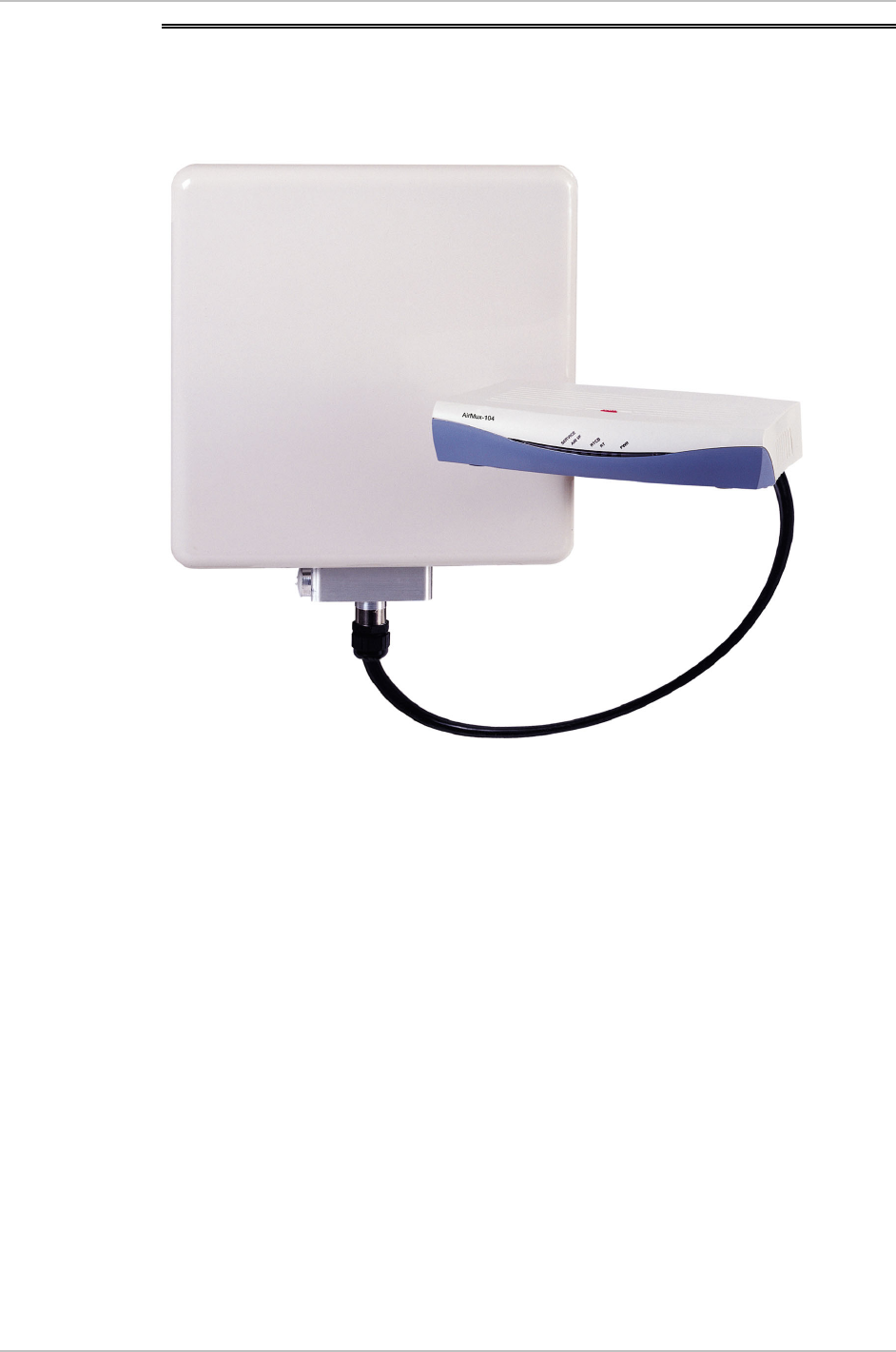
AirMux-104 Installation and Operation Manual Chapter 1 Introduction
Physical Description 1-3
1.2 Physical Description
AirMux-104 system consists of a radio terminal (RT) and an indoor unit (RTCB).
Figure 1-2 illustrates an AirMux-104 unit assembly.
Figure 1-2. AirMux-104 Unit
The front panel of the indoor unit (RTCB) includes five LEDs, which display the
status of E1, wireless link, self-test results, RT-to-RTCB link, and power status. For
detailed description of the front panel, see Chapter 4.
The rear panel of the indoor unit (RTCB) includes the power, user (LAN and E1),
and radio terminal connectors. The AirMux-104 rear panel is described in greater
detail in Chapter 3.

Chapter 1 Introduction AirMux-104 Installation and Operation Manual
1-4 Technical Specifications
1.3 Technical Specifications
Wireless Link Technology Spread spectrum
Frequency Band 5.725–5.850 GHz:
• ANSI Unlicensed National Information Infrastructure
(UNNII)
• ISM
Duplexing Method Time Division Duplex (TDD)
Capacity 2.6 Mbps, full duplex
Modulation QPSK
Channel Bandwidth
Resolution
10 MHz
Transmitter Power 16.7 dBm max
Receiver Sensitivity -90 dBm at BER 1E-8
Antenna Gain 20 dBi
Antenna Beam ±9° horizontal and vertical
RT Installation
Method
Mast or wall mounting
LAN Interface
PHY IF 10/100BaseT, auto-sensing
Framing/Coding IEEE 802.3/U
Bridging Self-learning, up to 4000 MAC addresses
Line Impedance 100Ω
VLAN Support Transparent
Data Rate 2 Mbps max
Connector RJ-45
E1 Interface Framing G.703, G.704 with or without CRC
Data Rate N x 64 kbps (n = 1, 2, ..., 32), user-selectable
Timing Plesiochronous
Connector RJ-45
Indicators PWR (green) Power status
RT (green/red) RT-to-RTCB link status
RTCB (green) RTCB self-test results
AIR I/F (green/red) Wireless link status
Service (green/red) E1 signal status

AirMux-104 Installation and Operation Manual Chapter 1 Introduction
Technical Specifications 1-5
Power Source 100–240 VAC via external AC/DC converter
Power Received by
the RT
-48 VDC
Power Consumption 25W max (RT and RTCB)
Connector 4-pin
Physical Outdoor Unit (RT)
Height 305 mm / 12 in
Width 305 mm / 12 in
Depth 72 mm / 2.8 in
Weight 3.3 kg / 7.2 lb
Indoor Unit (RTCB)
Height 44 mm / 1.7 in (1U)
Width 237 mm / 9.3 in
Depth 170 mm / 6.7 in
Weight 0.58 kg / 1.4 lb
Environment Radio Terminal
Enclosure All-weather case
Temperature -45–60°C/-49–140°F
Indoor Unit
Temperature -5–45°C/23–113°F
Humidity Up to 90%, non-condensing

Chapter 1 Introduction AirMux-104 Installation and Operation Manual
1-6 Technical Specifications

Introduction 2-1
Chapter 2
Initial Setup
This chapter describes configuration procedures, which must be performed prior
to the physical installation of the local and remote AirMux-104 units.
2.1 Introduction
Installation of the AirMux-104 system includes the following steps:
1. Installing management program on the network management station.
2. Performing preliminary configuration of the AirMux-104 units.
Selecting communication method
Local (direct connection via cross cable)
Network (connection via network to a specified IP address)
Configuring general parameters
Selecting product type (operation band)
Choosing operation channel within selected operation band
Assigning name to the radio link
Configuring service parameters
Selecting E1 service type (framed or unframed)
Enabling or disabling CRC-4 bits generation (for the framed E1 only)
Mapping timeslots (for the framed E1 only)
Selecting IP address, subnet mask, default gateway and trap destination.
3. Installing RT cable.
4. Installing Radio Terminals (RTs) and Radio Terminal Connection Boxes (RTCBs)
at the local and remote sites.
5. Connecting RTs and RTCBs and powering them up.
6. Aligning local and remote RTs.
7. Connecting user equipment to the local and remote RTCBs.
This chapter explains step 1 and step 2 of the AirMux-104 installation procedure.
Refer to Chapter 3 for the instructions on completing the AirMux-104 installation.
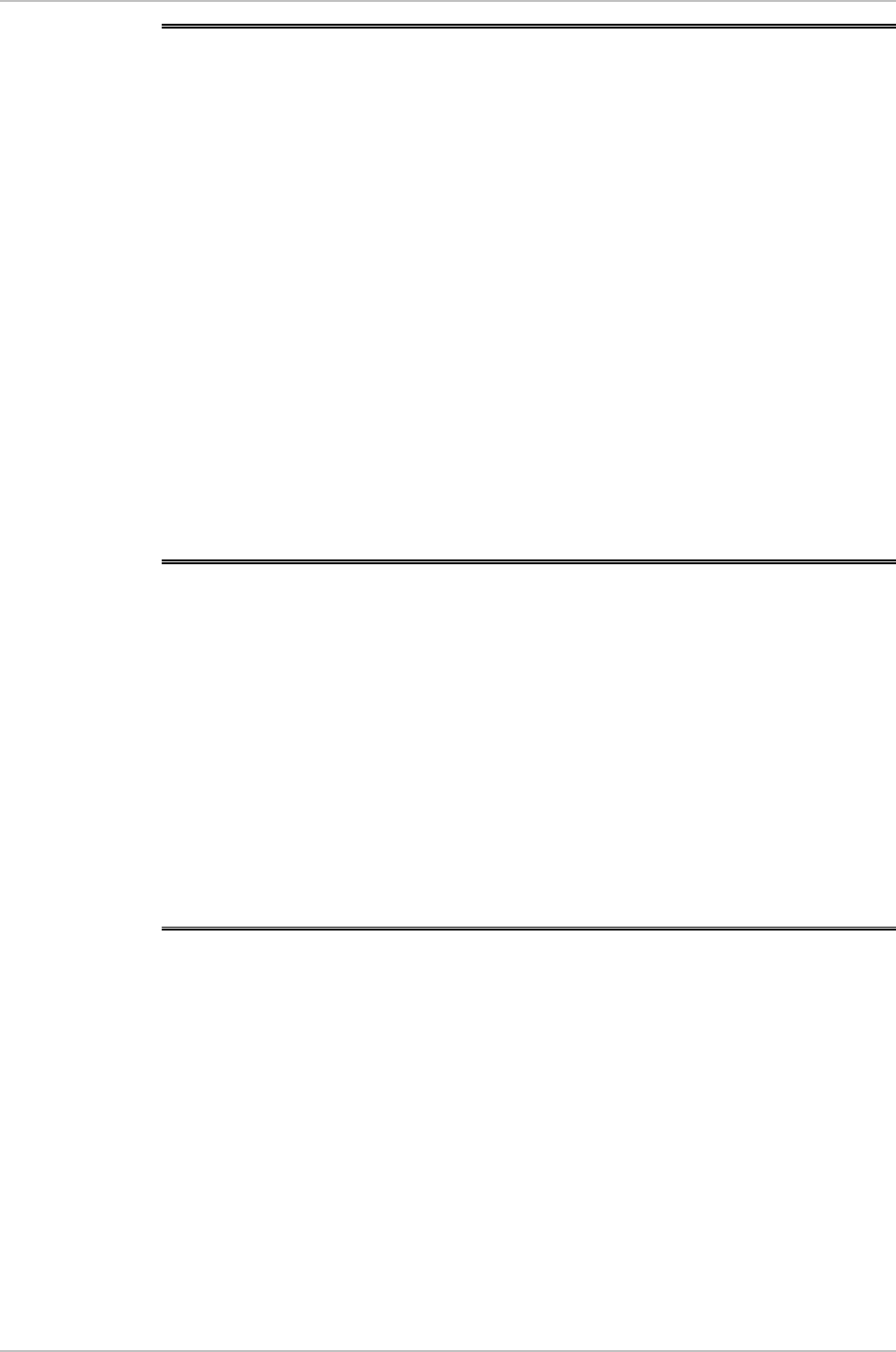
Chapter 2 Initial Setup AirMux-104 Installation and Operation Manual
2-2 Performing Initial Setup of AirMux-104
2.2 AirMux-104 System
AirMux-104 system comprises the following units:
• Radio Terminal (RT): An enclosed aluminum frame with a front sealed plastic
cover, containing an integrated transceiver with an antenna, RF module,
modem and standard interfaces. The RT stores all configuration parameters of
the AirMux-104 system.
RT includes 16-pin KRONE-type connector which receives -48 VDC, E1 and
Ethernet traffic from the indoor unit (RTCB).
The RT is attached to a mast or a wall using a special mounting kit. The RT
mounting kit is supplied with the unit.
• Radio Terminal Connection Box (RTCB): The unit that interfaces between
the RT and the users. It converts 220 VAC to -48VDC, and sends it on to the
RT. The RTCB also splits the incoming data from the RT cable into two
separate lines, one for E1 and one for IP. The RTCB does not store any
configuration data, that is why when replacing an RTCB, there is no need for
additional configuration of the AirMux-104 system.
2.3 Installing AirMux-104 Management Software
AirMux-104 management application is distributed on CD-ROM as an executable
file. The application can be run under Windows 98/2000/NT/XP operating
system.
To install the AirMux-104 management program:
1. Insert the distribution CD-ROM into your CD-ROM drive.
2. Run Airmux.exe from the CD-ROM drive.
3. Follow the onscreen instructions of the installation wizard to complete setup of
the AirMux-104 management program in the desired location.
2.4 Performing Initial Setup of AirMux-104
Before physical installation of the local and remote AirMux-104 units, you must
perform initial setup of the system and download configuration parameters to the
devices.
To perform initial setup:
1. Prepare the 2m RT-to-RTCB configuration cable for initial setup.
2. Connect the first RTCB to its RT using the 2m configuration cable.
3. Power up the first RTCB (see Connecting the Power in Chapter 3).
4. Connect management station to the first RTCB.
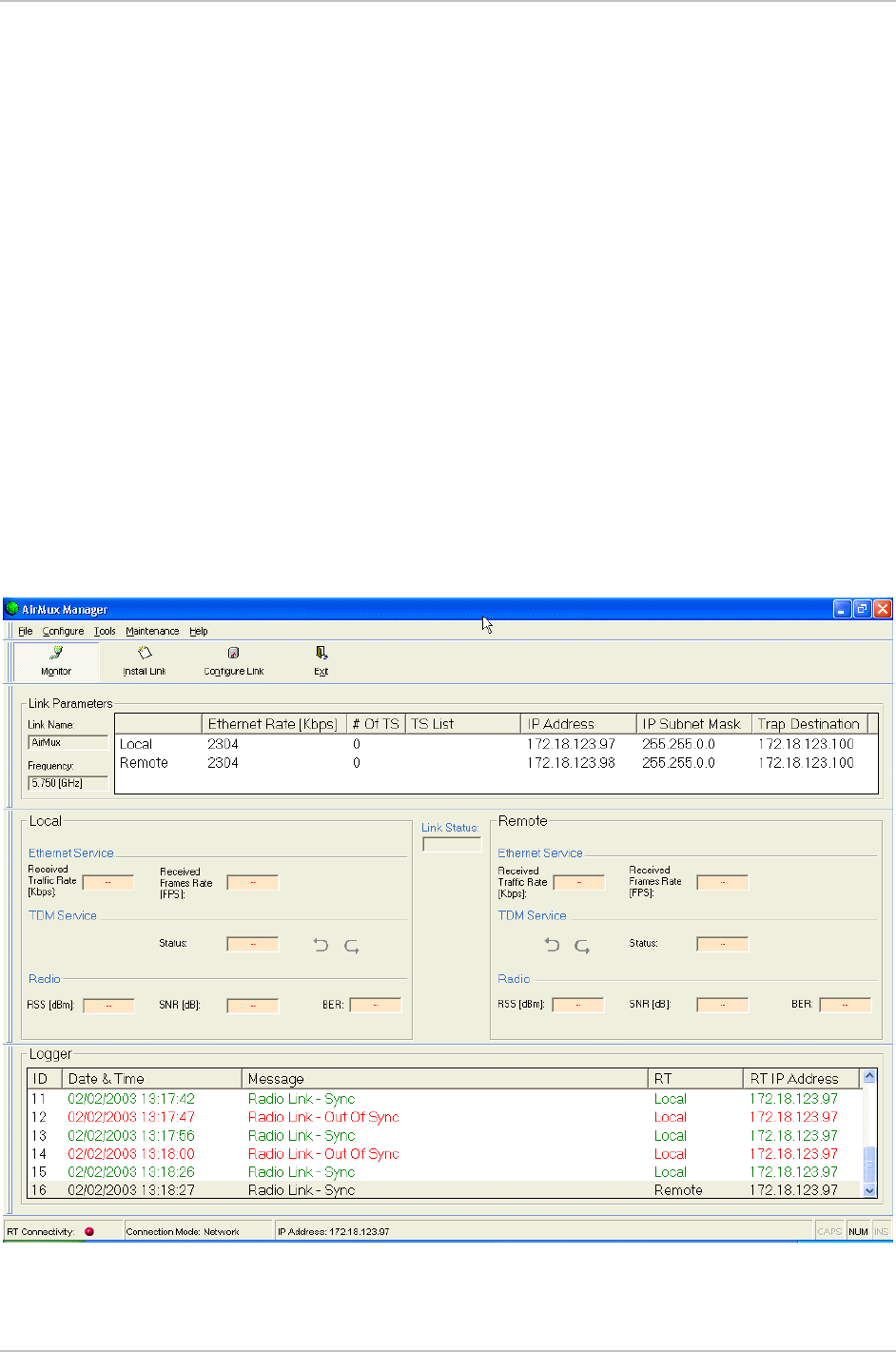
AirMux-104 Installation and Operation Manual Chapter 2 Initial Setup
Performing Initial Setup of AirMux-104 2-3
5. Perform initial configuration of AirMux-104 and download the new parameters
to the first unit.
6. Disconnect the configuration cable from the first RTSB and its RT.
7. Connect the second RTCB to its RT using the 2m configuration cable.
8. Connect the network management station to the second RTCB.
9. Download the new parameters to the second AirMux-104.
Any PC running the AirMux-104 management application can be used to
configure AirMux-104 units.
To connect the management station to RTCB:
• Connect a network interface card of the management station to the LAN
10/100 RJ-45 port local RTCB via a cross cable (refer to Appendix A for the
cable pinout).
You must start AirMux-104 from the unit, which is intended for local installation.
To start AirMux manager:
• From the Start menu, point to Programs, point to AirMux Manager, and then
click AirMux Manager.
The AirMux Manager Main menu is displayed.
Figure 2-1. AirMux Manager Main Menu
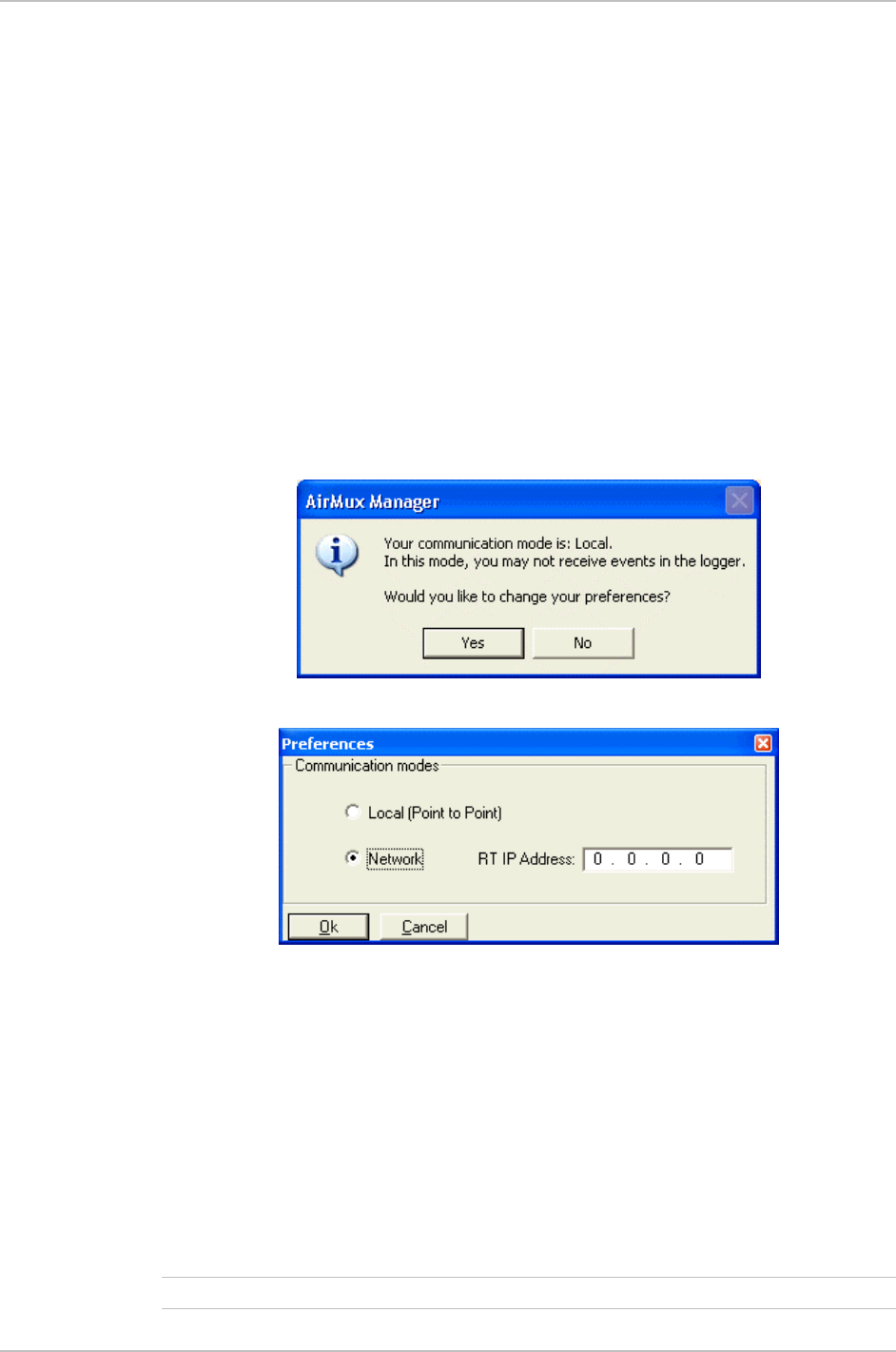
Chapter 2 Initial Setup AirMux-104 Installation and Operation Manual
2-4 Performing Initial Setup of AirMux-104
Configuring General Parameters
In order to establish communication link between manager station and
AirMux-104, you must select communication preference:
• Local (direct connection via cross cable)
• Network (connection via network to a specified IP address).
To change the communication preference:
1. In the Tools menu, select Preferences.
AirMux Manager displays confirmation message for the communication
preference change (see Figure 2-2).
2. If you intend to change the communication preference change, click Yes.
The Communication Preferences dialog box appears (see Figure 2-3).
3. In the Communication Preferences dialog box, click Network, and enter the
RT IP address.
4. Click OK.
Figure 2-2. Confirmation Message for Communication Preference Change
Figure 2-3. Communication Preferences Dialog Box
To change general parameters:
1. In the Main menu, click Install Link.
2. The General Parameters dialog box appears (see Figure 2-4).
3. From the General Parameters dialog box, select the following parameters:
Product type – select the AirMux-104 product type:
Low band (5.255 GHz to 5.345 GHz)
Mid band (5.470 GHz to 5.725 GHz)
High band (5.730 GHz to 5.850 GHz)
Currently AirMux-104 supports only the high band operation.
Note
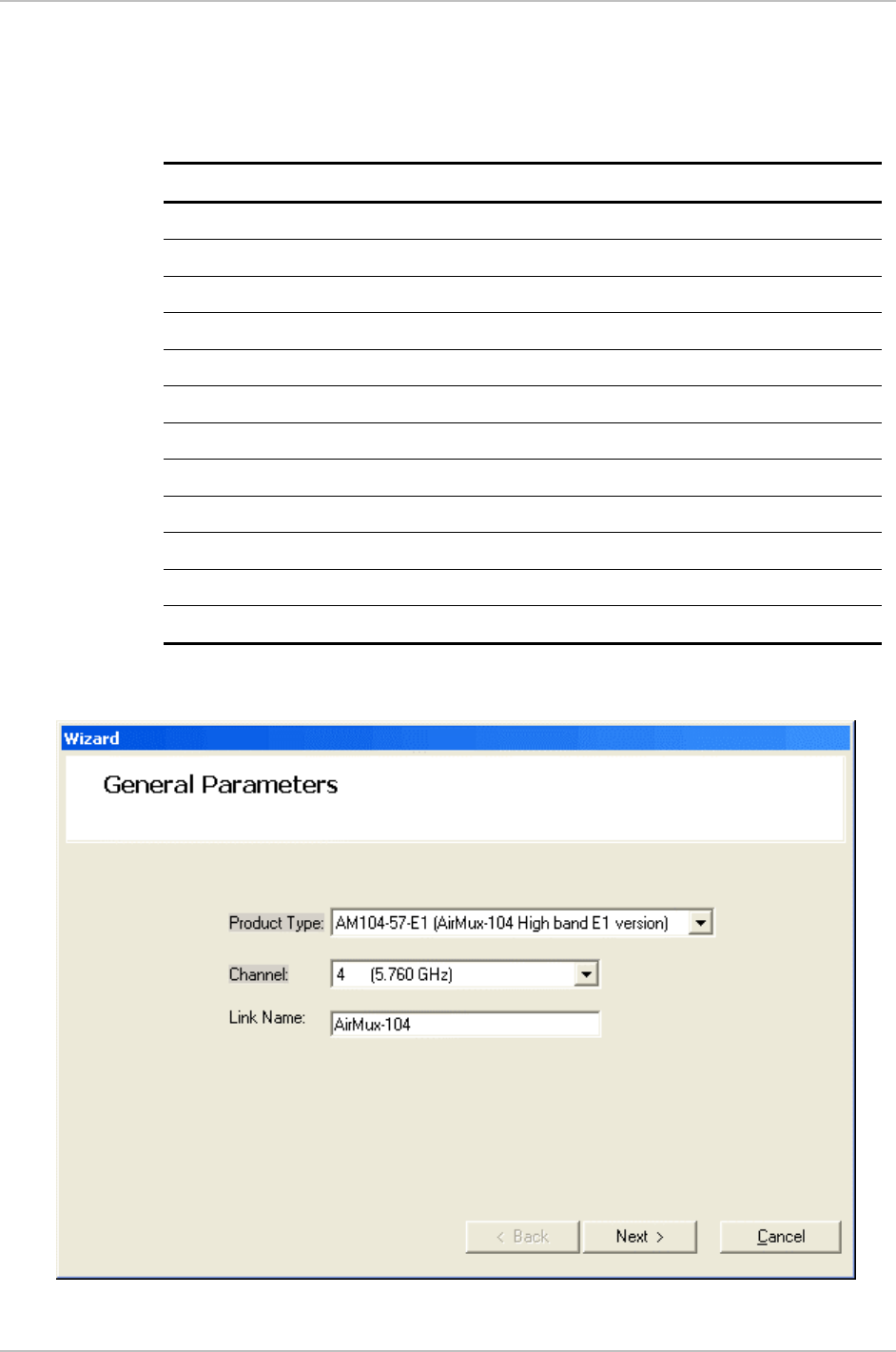
AirMux-104 Installation and Operation Manual Chapter 2 Initial Setup
Performing Initial Setup of AirMux-104 2-5
Channel – select operating channel supported by the current band
Link name – enter a name for the link identification.
Table 2-1 lists channels and frequencies for DSSS and UNII bands.
Table 2-1. AirMux-104 Channels and Frequencies
Channel DSSS Band UNII Band
1 5730 MHz –
2 5740 MHz 5740 MHz
3 5750 MHz 5750 MHz
4 5760 MHz 5760 MHz
5 5770 MHz 5770 MHz
6 5780 MHz 5780 MHz
7 5790 MHz 5790 MHz
8 5800 MHz 5800 MHz
9 5810 MHz 5810 MHz
10 5820 MHz –
11 5830 MHz –
12 5840 MHz –
4. Click Next.
The Service Parameters dialog box appears (see Figure 2-5).
Figure 2-4. General Parameters Dialog Box
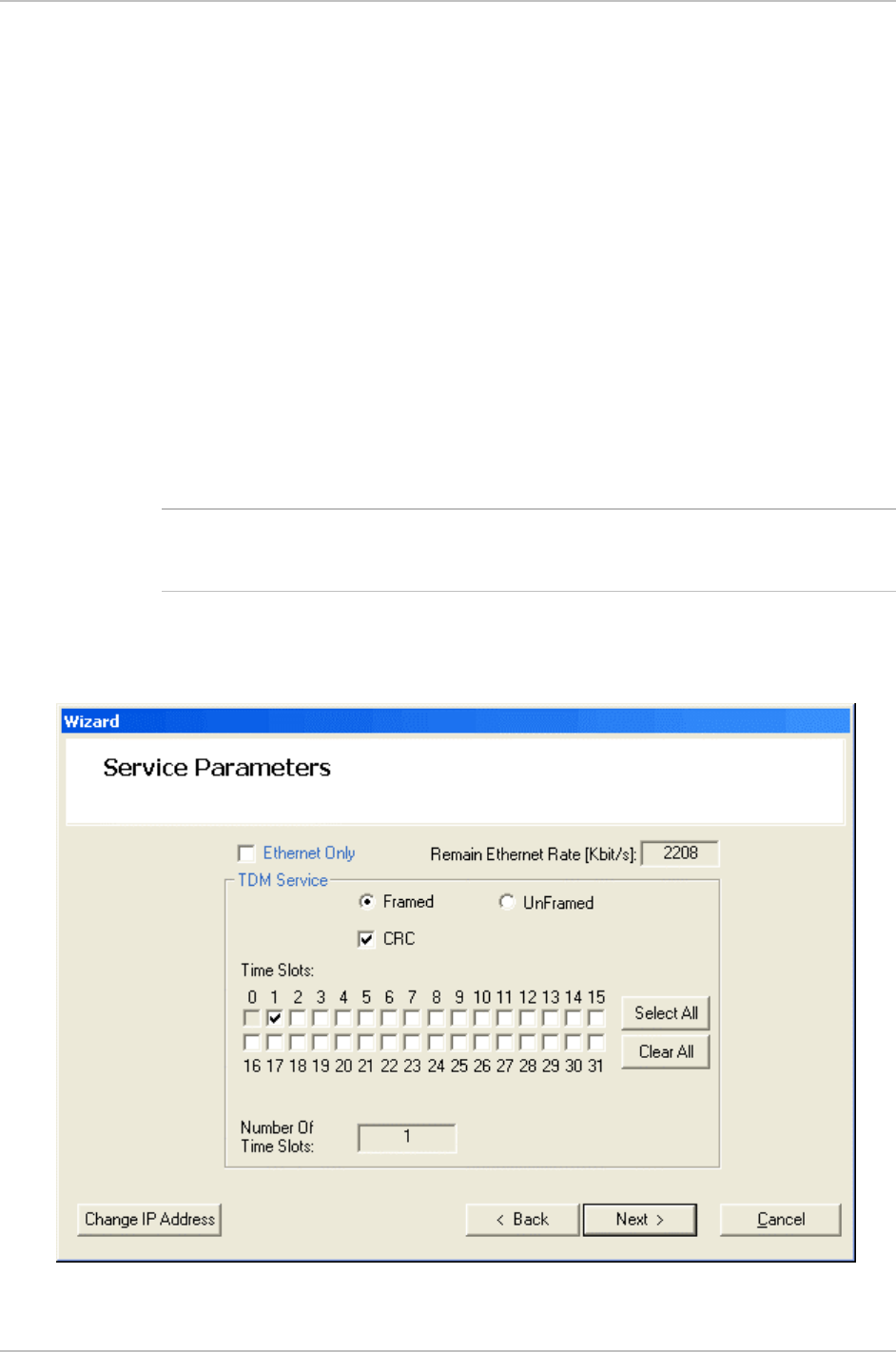
Chapter 2 Initial Setup AirMux-104 Installation and Operation Manual
2-6 Performing Initial Setup of AirMux-104
Configuring Service Parameters
In the Service Parameters dialog box you can configure E1 and Ethernet
parameters. In addition, you can assign IP addresses of the local and remote
AirMux-104 units.
To configure E1 and Ethernet parameters:
1. In the General Parameters dialog box, perform the following steps:
Select the Ethernet Only check box, if you intend to transmit Ethernet data
only.
Select E1 service type, framed or unframed.
Framed E1 – assign timeslots to carry data.
You can assign all timeslots by clicking Select All, clear you selection by
clicking Clear All.
Timeslot 0 is reserved for framing information and cannot be selected to
carry user’s data.
Unframed E1 – all timeslots are assigned to carry data automatically.
When you assign timeslots to carry E1 data, AirMux-104 automatically calculates the
bandwidth remained for the Ethernet traffic. This value is displayed in the Data Rate
field at the right-hand corner of the Service Parameters dialog box (see Table 2-2).
Enable CRC-4 bit generation, if required.
Click Next, if you do not intend to configure IP parameters of the
AirMux-104 units.
Figure 2-5. Service Parameters Dialog Box
Note

AirMux-104 Installation and Operation Manual Chapter 2 Initial Setup
Performing Initial Setup of AirMux-104 2-7
Table 2-2. Correlation between the Number of Assigned Timeslots and Remaining Ethernet Bandwidth
Number of E1 Timeslots Remaining Ethernet Bandwidth
[kbps]
0 2304
1 2208
2 2112
3 1920
4 1920
5 1920
6 1824
7 1728
8 1728
9 1536
10 1536
11 1536
12 1440
13 1440
14 1248
15 1248
16 1248
17 1152
18 1152
19 1056
20 864
21 864
22 864
23 768
24 672
25 672
26 480
27 480
28 384
29 384
30 288
31 96
32 96
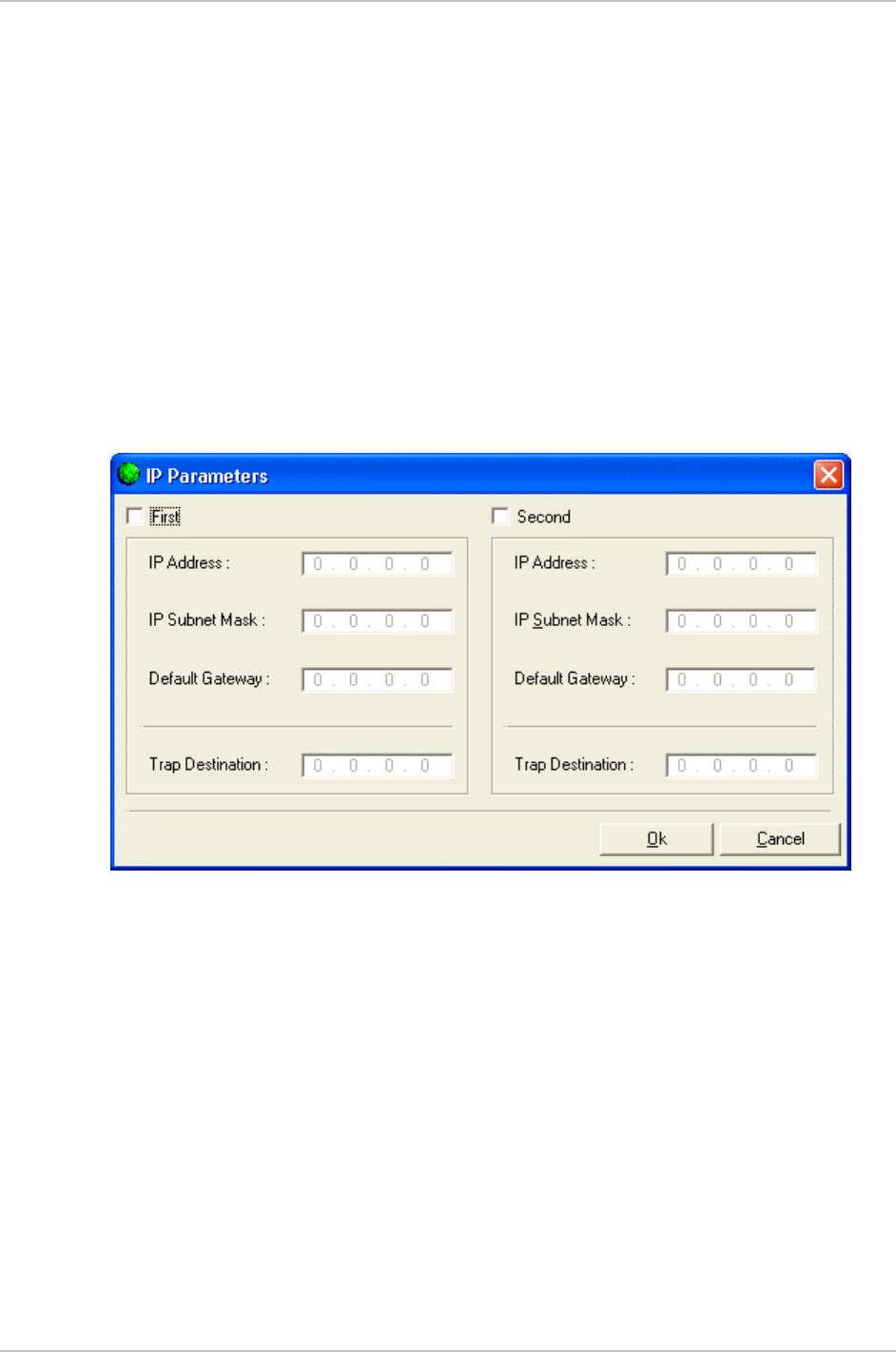
Chapter 2 Initial Setup AirMux-104 Installation and Operation Manual
2-8 Performing Initial Setup of AirMux-104
To assign IP addresses to the local and remote units:
1. In the Service Parameters dialog box, click Change IP Address.
The IP Parameters dialog box appears (see Figure 2-6).
2. In the IP Parameters dialog box, select the First check box to configure the IP
parameters of the first AirMux-104.
or
Select the Second check box to configure the IP parameters of the second
AirMux-104.
3. In the IP Parameters dialog box, enter IP address, IP subnet mask, default
gateway and trap destination values for the first and/or second unit.
4. Click OK.
5. The Service Parameters dialog box appears (see Figure 2-5).
6. From the Service Parameters dialog box, click Next to proceed with the
configuration download to the first unit.
Figure 2-6. IP Parameters
Downloading Configuration Parameters
After completing system and service configuration, you must download new values
to both AirMux-104 devices.
To download configuration data:
1. Make sure that the management station is connected to the 10/100 LAN port
of the RTCB, and click the Download button in the Download Data dialog box
(see Figure 2-7).
Downloading process to the first RT begins. Once the downloading to the
first unit is completed, the upper Download button becomes dimmed.
2. Click the lower Download button to download configuration data to the
second RT.
After successfully completing software download to the second unit,
AirMux-104 displays Installation Completed Successfully message (see Figure 2-8).
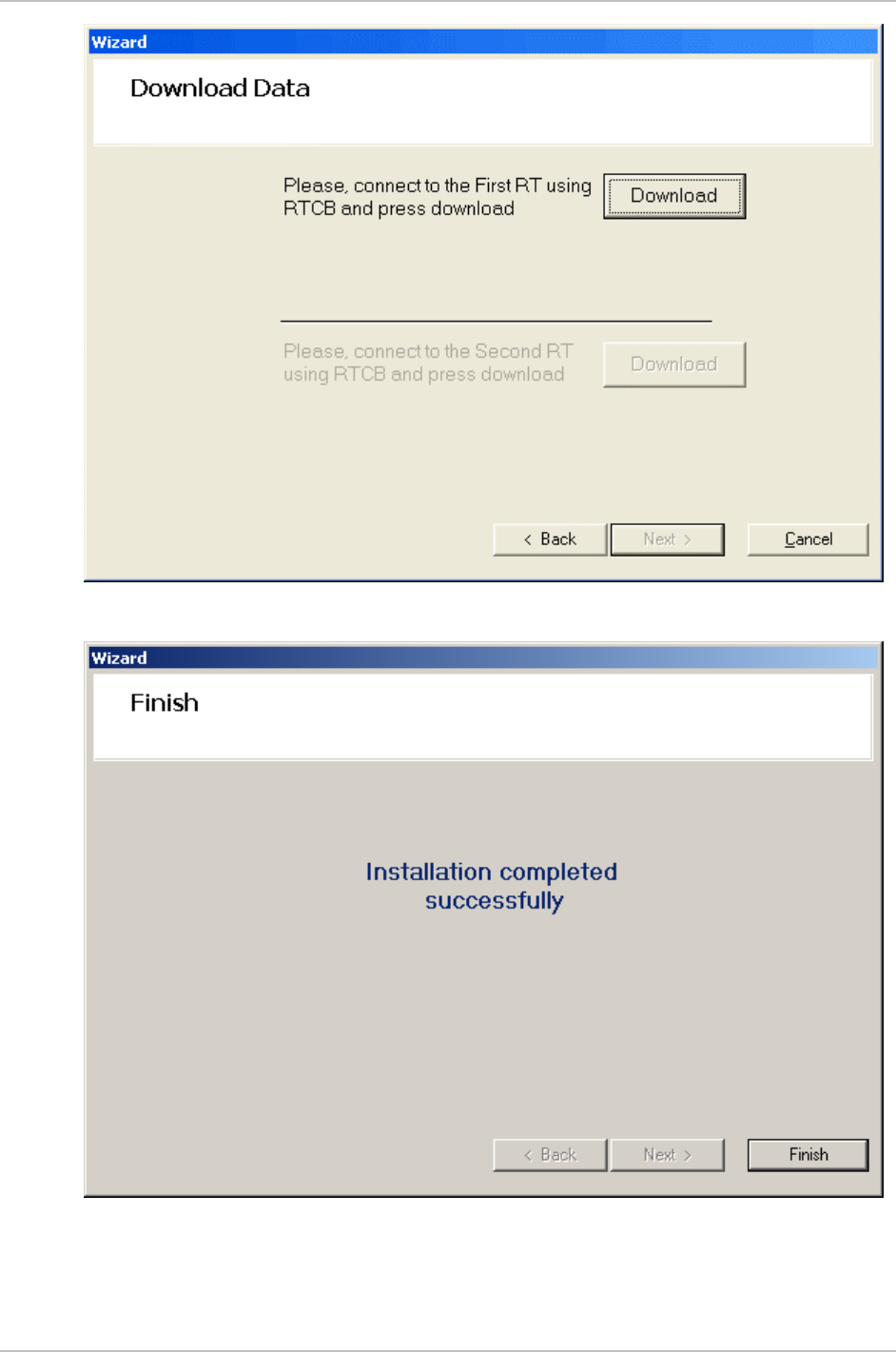
AirMux-104 Installation and Operation Manual Chapter 2 Initial Setup
Performing Initial Setup of AirMux-104 2-9
Figure 2-7. Download Data Dialog Box
Figure 2-8. Installation Completed Successfully Message

Chapter 2 Initial Setup AirMux-104 Installation and Operation Manual
2-10 Performing Initial Setup of AirMux-104

Package Contents 3-1
Chapter 3
Installation and Setup
This chapter describes installation and setup procedures for AirMux-104 system.
After installing the unit, refer to Chapter 4 for configuration instructions.
In case a problem encountered, refer to Chapter 5 for test and diagnostic
instructions.
Internal settings, adjustment, maintenance, and repairs may be performed
only by a skilled technician who is aware of the hazards involved.
Always observe standard safety precautions during installation, operation, and
maintenance of this product.
3.1 Site Requirements and Prerequisites
For the RTCB, allow at least 90 cm (36 in) of frontal clearance for operating and
maintenance accessibility. Allow at least 10 cm (4 in) clearance at the rear of the
unit for signal lines and interface cables.
The ambient operating temperature should be -45–60°C/-49–140°F (RT), or
-5–45°C/23–113°F (RTCB) at a relative humidity of up to 90%, non-condensing.
3.2 Package Contents
The AirMux-104 package includes the following items:
• RT (radio terminal)
• RTCB (radio terminal connection box)
• RT cable
• AC/DC power converter
• AirMux-104 installation and operation manual
• RT mounting kit.
Warning

Chapter 3 Installation and Setup AirMux-104 Installation and Operation Manual
3-2 Installation and Setup
3.3 Installation and Setup
Physical installation of the AirMux-104 system includes the following steps in the
given order:
1. Outdoor installation
Preparing the RT cable
Connecting the RT and the RTCB via the RT cable.
Mounting and aligning the RT.
2. Indoor installation
Connecting user equipment
Connecting power.
Figure 3-1 illustrates a typical installation of AirMux-104 (local or remote).
Circuit
Breaker
16A
Radio
Ter m i na l
220 VAC
AC/DC
Converter
RTCB
-48 VDC
Mux/PBX
Hub/Router
Ethernet
E1
RT Cable (100m max)
(Ethernet, E1, -48 VDC)
Indoo
r
Outdoor
Figure 3-1. Typical Installation (for Reference and Illustration only)

AirMux-104 Installation and Operation Manual Chapter 3 Installation and Setup
Installation and Setup 3-3
Outdoor Installation
The outdoor installation process involves preparing the RT cable, connecting the
RT and the RTCB, mounting the RT on the mast and aligning the RT.
Preparing RT Cable
The RT cable conducts all of the user traffic between the RTCB and the RT. The RT
cable also provides -48 VDC supply to the RT. The maximum length for one leg of
the RT cable is 100m (328 ft).
To prepare the RT cable:
1. Measure the distance between the RT and the RTCB along the assigned path.
2. Cut the required length of RT cable, allowing some spare length.
3. Assemble the DB-25 connector at the RTCB end of the cable, refer to
Appendix A for the connector pinout.
4. Route the cable from the RT location into the building, leaving some spare.
Secure the cable along its path.
Connecting the RT to the RTCB
The RT cable is connected to the DB-25 female connector on the RTCB rear
panel, designated RT CONNECTION. Figure 3-2 illustrates a typical panel of the
RTCB.
E1
RT CONNECTION LAN 10/100
ACTLINK
Figure 3-2. Rear Panel
Mounting and Aligning the RT
The RT is the transmitting and receiving element of the AirMux-104 system. The
RT can be mounted on a mast or a wall. In both installation types, the supplied
mounting kit is used to secure the RT. Appendix B describes the mast/wall
installation instructions.
You can verify that the AirMux-104 units are aligned using the RSS/SNR, LINK and
STATUS LEDs located at the base of the RT. Alternatively, this can be done via the
AirMux management software.
Prior to connecting cables to the RT, the protective earth terminal (screw) of
the RT must be connected to an external protective ground conductor or to a
grounded mast.
Only a qualified person using the proper safety equipment should climb the
antenna mast. Only trained professional installers should be used when
installing or dismantling RTs and masts.
Warning

Chapter 3 Installation and Setup AirMux-104 Installation and Operation Manual
3-4 Installation and Setup
To install the RT:
1. Verify that the RT mounting brackets are properly grounded.
2. Attach the RT unit to the mast, using the two strap clamps. Refer to Appendix B
for the RT mounting instructions.
3. Connect the ground cable to the chassis point on the RT.
4. Attach the RT cable to the 16-pin Krone-type connector, refer to Appendix A
for the connector pinout.
5. Secure the cables to the mast or brackets using provided UV-rated cable ties.
6. Repeat the procedure at the remote site.
Do not tightly secure the RT to its mounting brackets, if the alignment process of the
antenna is not yet complete.
When installing the RT, it is important to check that there are no direct obstructions
in front of the RT or interference from man-made obstacles.
To align the RTs via RT LEDs monitoring:
1. Connect power to the RTCBs.
2. Turn the local RT in the direction of the remote RT.
3. At the remote site, align the RT to face the local RT. (Align visually or by using
a map and a compass). Use the RSS/SNR, LINK and STATUS LEDs at the base
of the RT for the link quality indication (see Figure 3-3, Table 3-1 and
Table 3-2):
RTs are not aligned:
Triple RSS/SNR LED is blinking
LINK LED is OFF
STATUS LED is blinking slowly.
RTs are aligned:
Triple RSS/SNR LED is blinking or lit steadily
LINK LEDs is lit steadily
STATUS LED is blinking rapidly.
4. Repeat step 3 for the local RT to complete the installation procedure.
RSS/SNR
LINK
STATUS
Figure 3-3. RT LEDs
Note
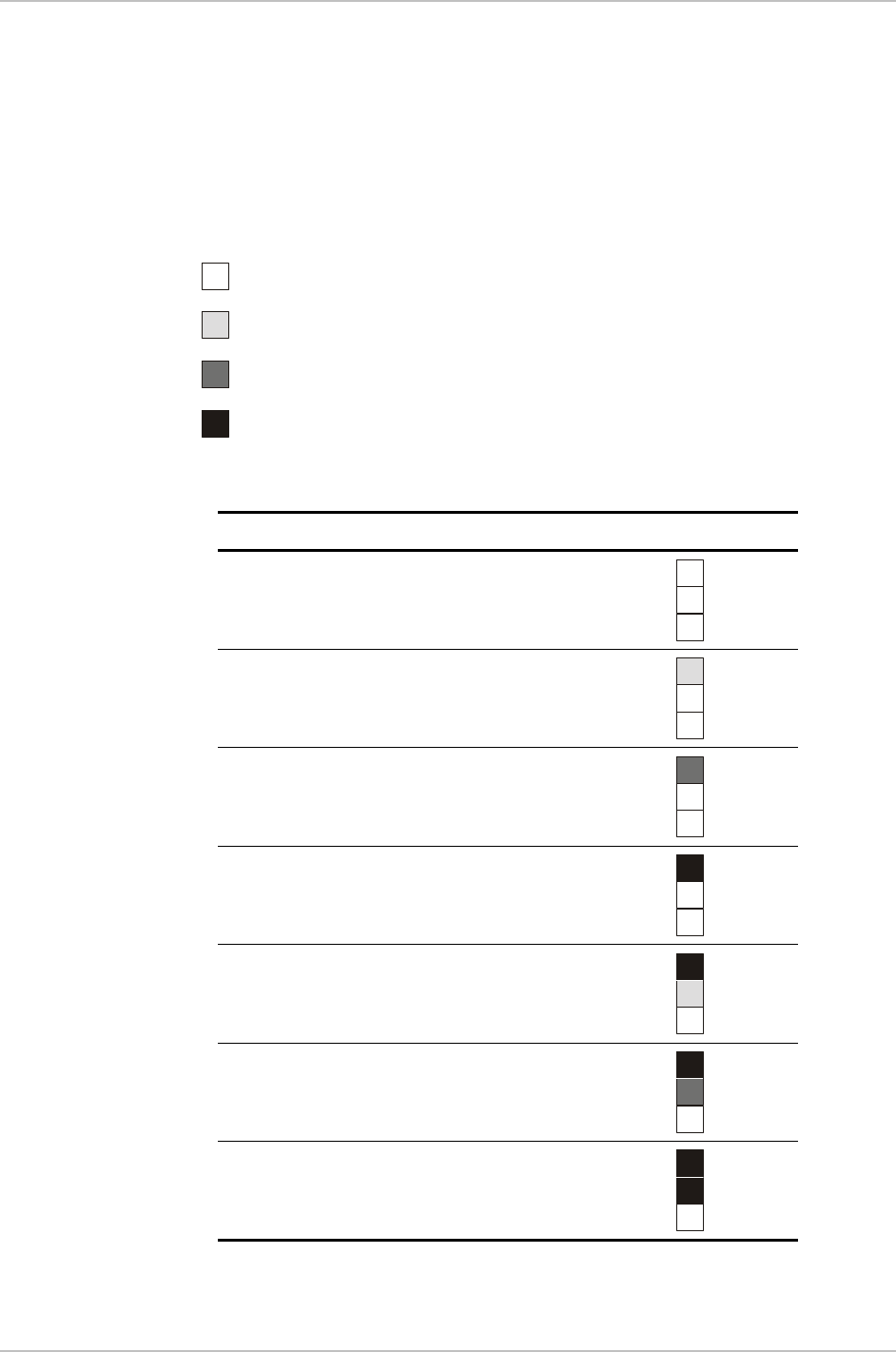
AirMux-104 Installation and Operation Manual Chapter 3 Installation and Setup
Installation and Setup 3-5
When AirMux-104 units are not synchronized (LINK LED is OFF), the RSS/SNR
LED indicates the radio signal strength (the more LED segments are lit, the stronger
is the radio signal).
When the AirMux-104 units are synchronized (LINK LED is ON), the RSS/SNR LED
indicates the signal-to-noise ratio (the more LED segments are lit, the better is
radio link quality)
Table 3-1 and Table 3-2 explain relation between the blinking and lit segments of
the RSS/SNR LED and RSS/SNR values.
• represents a LED segment in the OFF state.
• represents a slowly blinking LED segment
• represents a rapidly blinking LED segment
• represents a steadily lit LED segment.
Table 3-1. RSS/SNR Triple LED Indication (RSS Mode)
Indication Minimum Maximum Level LEDs Status
RSS -88 dBm 0
RSS -87 dBm -87 dBm 1
RSS -86 dBm -86 dBm 2
RSS -85 dBm -84 dBm 3
RSS -83 dBm -81 dBm 4
RSS -80 dBm -75 dBm 5
RSS -74 dBm -67 dBm 6
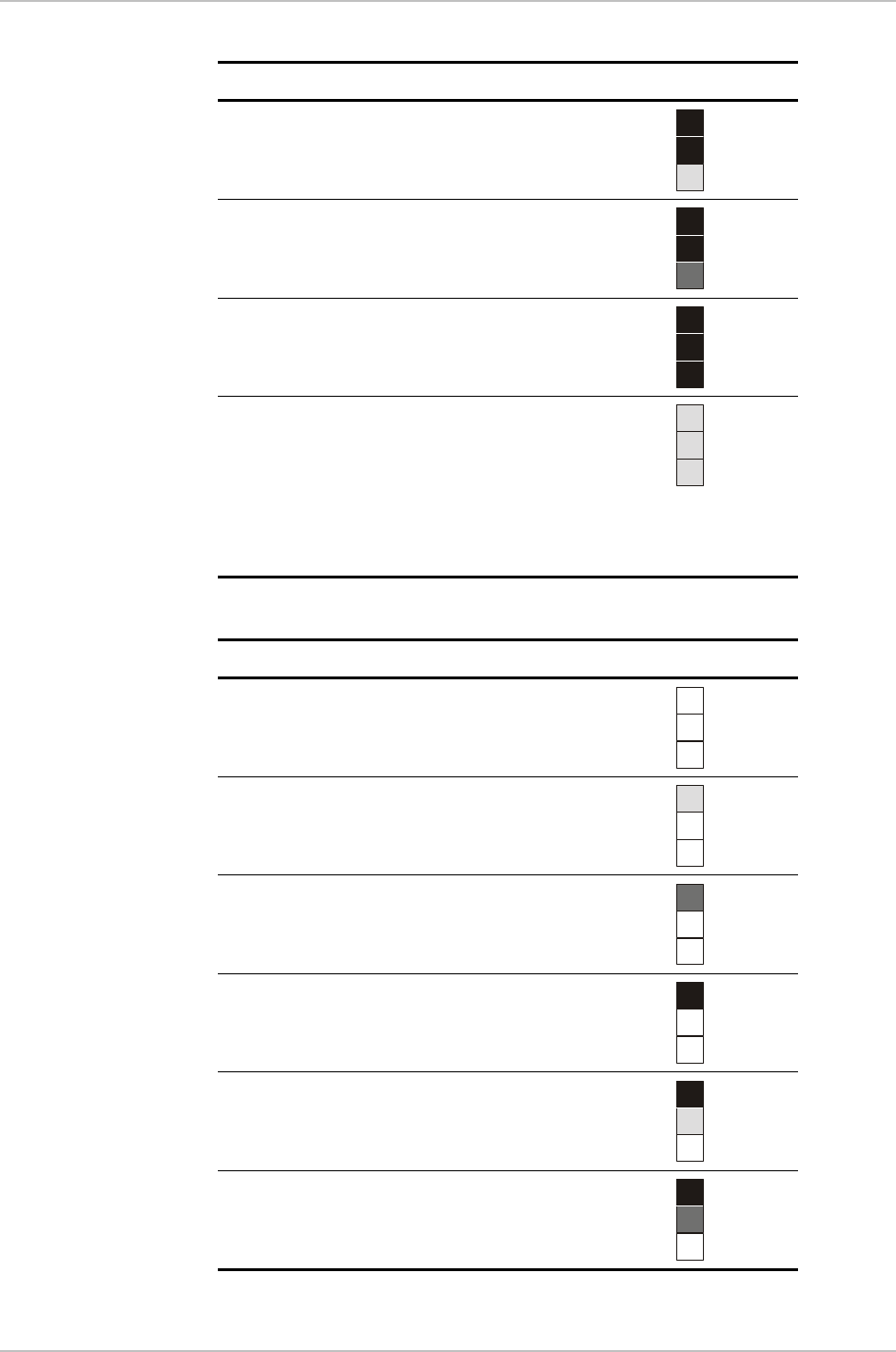
Chapter 3 Installation and Setup AirMux-104 Installation and Operation Manual
3-6 Installation and Setup
Table 3-1. RSS/SNR Triple LED Indication (RSS Mode) (Cont.)
Indication Minimum Maximum Level LEDs Status
RSS -66 dBm -53 dBm 7
RSS -52 dBm -30 dBm 8
RSS -29 dBm 2 dBm 9
RSS 2 dBm 10
Note: Level 10 (all three LED segments are blinking slowly) indicates
that the radio signal is excessively strong. That may cause link
quality deterioration.
Table 3-2. RSS/SNR Triple LED Indication (SNR Mode)
Indication Minimum Maximum Level LEDs Status
SNR 7 dB 0
SNR 8 dB 8 dB 1
SNR 9 dB 9 dB 2
SNR 10 dB 10 dB 3
SNR 11 dB 11 dB 4
SNR 12 dB 12 dB 5
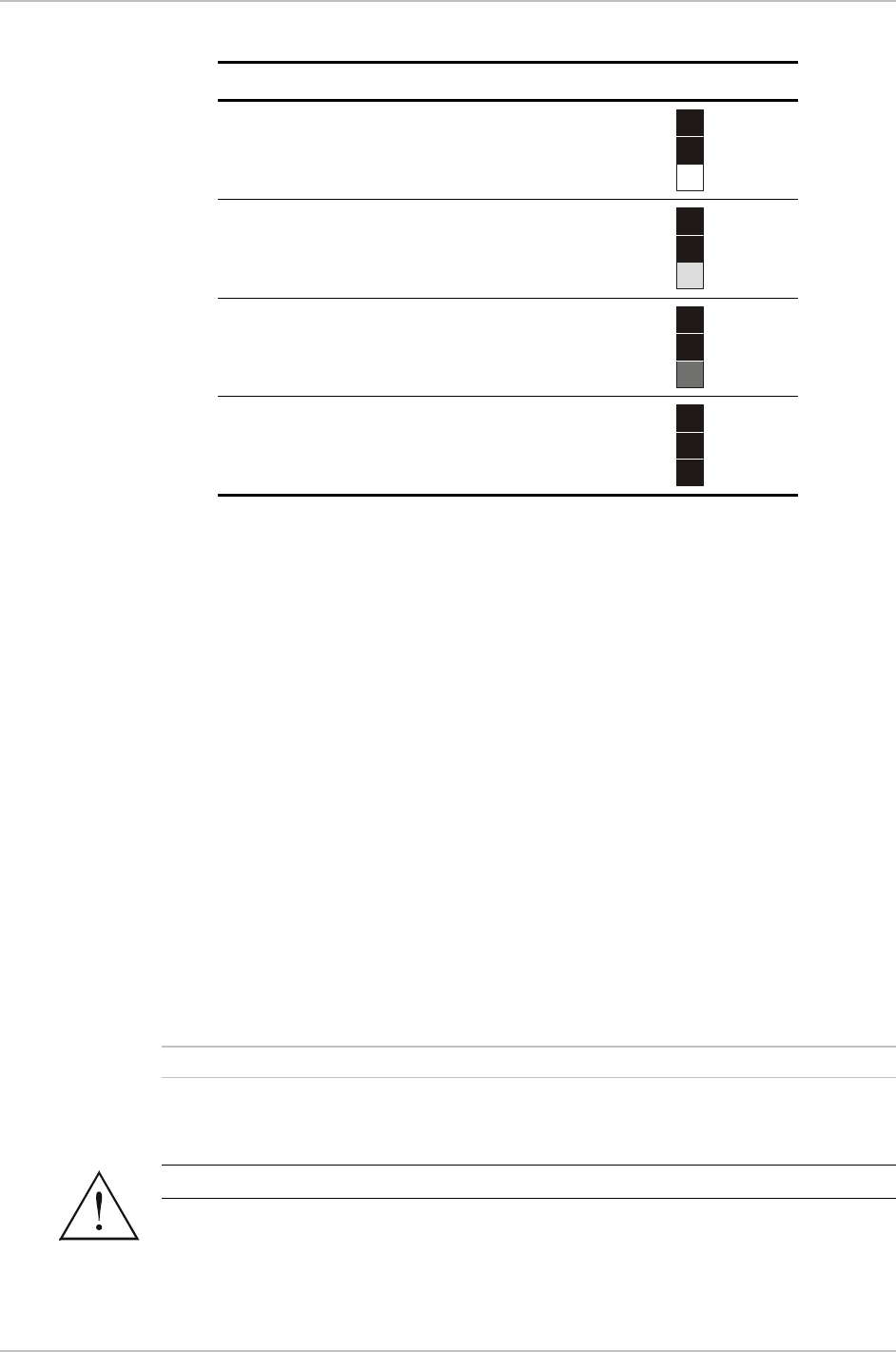
AirMux-104 Installation and Operation Manual Chapter 3 Installation and Setup
Installation and Setup 3-7
Table 3-2. RSS/SNR Triple LED Indication (SNR Mode) (Cont.)
Indication Minimum Maximum Level LEDs Status
SNR 13 dB 13 dB 6
SNR 14 dB 14 dB 7
SNR 15 dB 15 dB 8
SNR 16 dB 16 dB 9
To align the RTs using the AirMux Manager:
1. Connect power to the RTCBs.
2. Turn the local RT in the direction of the remote RT.
3. At the remote site, align the RT to face the local RT. (Align visually or by using
a map and a compass).
4. Repeat steps 3 to 4 for the local RT to complete the installation procedure.
5. Make sure that the management station is properly connected to the local
RTCB, and the AirMux Manager application is running.
6. In the Main menu, click Monitor.
Once the wireless link is established between the local and remote units,
the Link Status indication bar in the middle of the Main menu turns green.
In addition, Radio Link - Sync message appears in the logger at the bottom
of the Main menu.
7. Check the radio signal strength (RSS) and sound-to-noise ratio (SNR) in the
Main menu. Rotate the local RT until the best RSS is found (better than -
88 dBm). The SNR should be at least 9 dB. View these parameters for about
15 min. to verify stability.
Try achieving the best possible RSS and SNR values.
8. After achieving the best RSS and SNR levels, permanently attach the RT to the
mast. Refer to Appendix B for the RT mounting instructions.
Do not stand in front of live radio terminal.
Warning
Note

Chapter 3 Installation and Setup AirMux-104 Installation and Operation Manual
3-8 Installation and Setup
Indoor Installation
The installation process for the indoor unit involves installing the RTCB and making
all necessary connection to the user equipment and the power source.
Connecting the User Equipment
The RTCB is a standalone desktop, wall-mounted or rack-installed unit. Figure 3-2
illustrates a typical rear panel of the RTCB.
To connect user equipment to the RTCB:
1. Connect user mux or PBX to the RTCB rear panel RJ-45 port designated E1,
refer to Appendix A for the connector pinout.
2. Connect user hub/router or any other compatible device to the RTCB rear
panel RJ-45 port designated 10/100 LAN, refer to Appendix A for the
connector pinout.
Use straight cable for router connection, or cross cable for the PC connection.
Connecting the Power
Before connecting any cable, the protective earth terminals of the AC/DC
adapter must be connected to the protective ground conductor of the mains
power cord. If you are using an extension cord (power cable) make sure it is
grounded as well.
Any interruption of the protective (grounding) conductor (inside or outside the
instrument) or disconnecting of the protective earth terminal can make this
unit dangerous. Intentional interruption is prohibited.
Power is supplied to AirMux-104 via external AC/DC converter which receives
power from 220 VAC source and converts it to -48 VDC.
To connect the power:
1. Connect the 4-pin plug of the AC/DC converter to the 4-pin DC power
connector on the RTCB rear panel.
2. Connect the AC/DC converter 3-prong plug to the mains outlet.
The unit turns on automatically upon connection to the mains.
Note
Warning
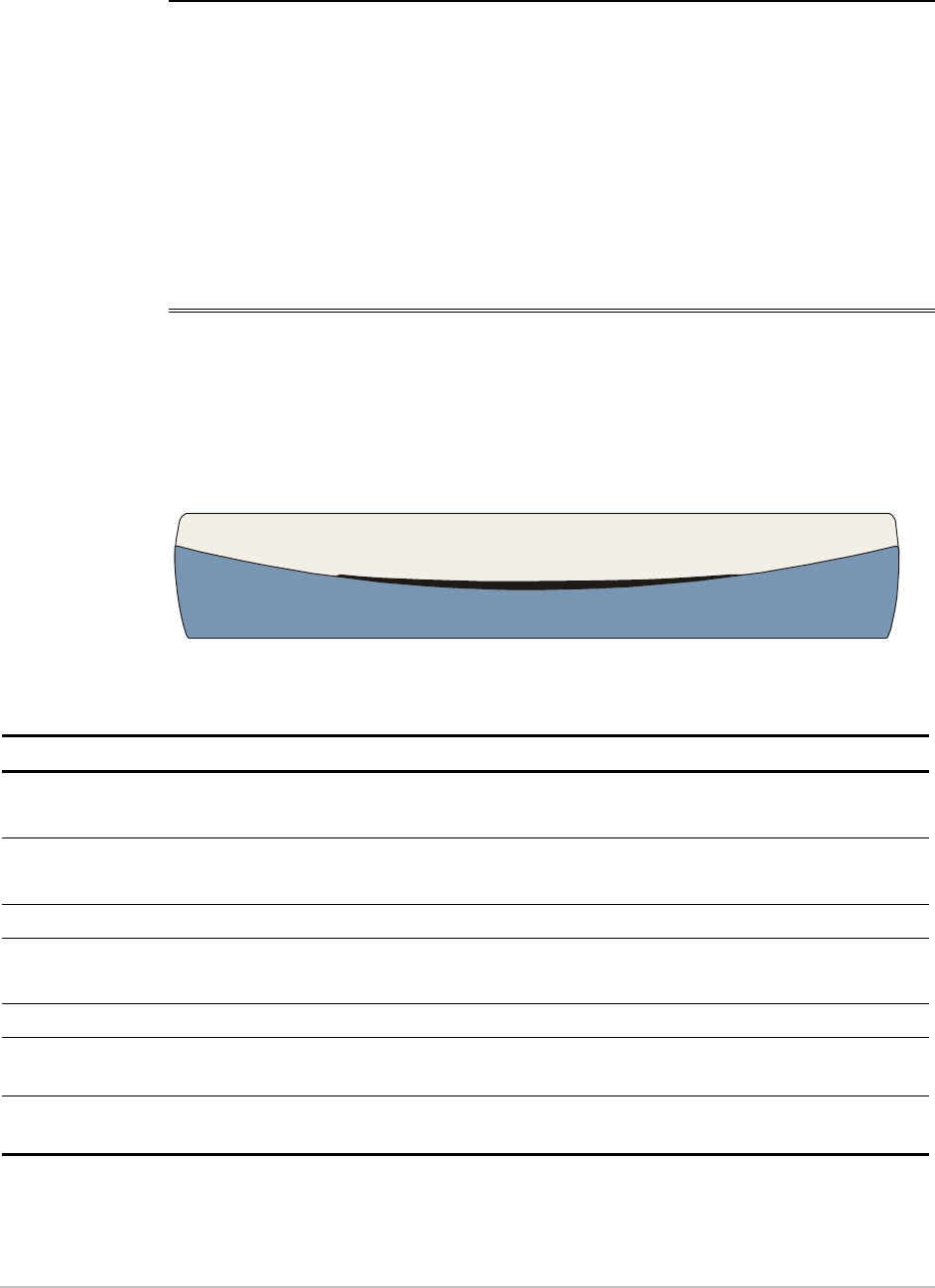
Front Panel Indicators 4-1
Chapter 4
Operation
This chapter provides the following information for AirMux-104:
• AirMux-104 front-panel indicators
• Operating procedures (turn-on, front-panel indications, performance
monitoring and turn-off)
• Procedures for changing AirMux-104 configuration parameters.
4.1 Front Panel Indicators
The front panel of AirMux-104 includes a series of LED indicators that show the
current operating status of the unit.
Figure 4-1 shows the front panel of the AirMux-104 unit. Table 4-1 and Table 4-2
describe the AirMux-104 indicators.
AirMux-104
SERVICE
AIR I/F
RTCB
RT
PWR
Figure 4-1. Front Panel
Table 4-1. RTCB LEDs
Name Function Location
SERVICE
(green/red)
ON (green) – E1 line is synchronized
ON (red) – Alarm is detected at the E1 interface
Front panel
AIR I/F (red) ON (green) – Wireless link is synchronized
ON (red) – Wireless link lost synchronization
Front panel
RTCB (green) ON – RTCB self-test was completed successfully Front panel
RT
(green/red)
ON (green) – RT-to-RTCB communication link is operating properly
ON (red) – RT-to-RTCB communication link is disrupted
Front panel
PWR (green) ON – A power supply is ON Front panel
LINK (green) ON – Good Ethernet link integrity Rear panel 10/100
LAN connector
ACT (yellow) Blinks according to the Ethernet traffic Rear panel 10/100
LAN connector

Chapter 4 Operation AirMux-104 Installation and Operation Manual
4-2 Operating AirMux-104
Table 4-2. RT LEDs
Name Function Location
RSS/SNR
(triple yellow LED)
ON (AirMux-104 units are not synchronized) – Received signal
strength
ON (AirMux-104 units are synchronized) – Signal-to-Noise
ratio
RT
LINK
(square green LED)
OFF – AirMux-104 units are not synchronized
ON – AirMux-104 units are synchronized
RT
STATUS
(circular green LED)
Blinks slowly – AirMux-104 units are not synchronized
Blinks rapidly – AirMux-104 units are synchronized
RT
4.2 Operating AirMux-104
Turning On AirMux-104
To turn on AirMux-104:
• Connect the AC/DC converter to the RTCB power connector and to the mains.
The PWR indicator lights up and remains lit as long as the RTCB receives
power.
AirMux-104 requires no operator attention once installed, with the exception of
occasional monitoring of front panel indicators and statistics data. Intervention is
only required when AirMux-104 must be configured to its operational
requirements, or diagnostic tests are performed.
Normal Indications
Upon turning on AirMux-104, the PWR LED in the front panel lights to indicate
that AirMux-104 is on. Table 4-3 shows the correct status of the indicators a few
seconds after power-up.
Table 4-3. AirMux-104 Indicator Status
Indicator Status
PWR ON
RTCB ON
If the above LED indications do not appear following initial power turn-on, refer to
Chapter 5 for the diagnostic test instructions.
Turning Off AirMux-104
To turn off AirMux-104:
• Remove the AC/DC converter power cord from the mains.
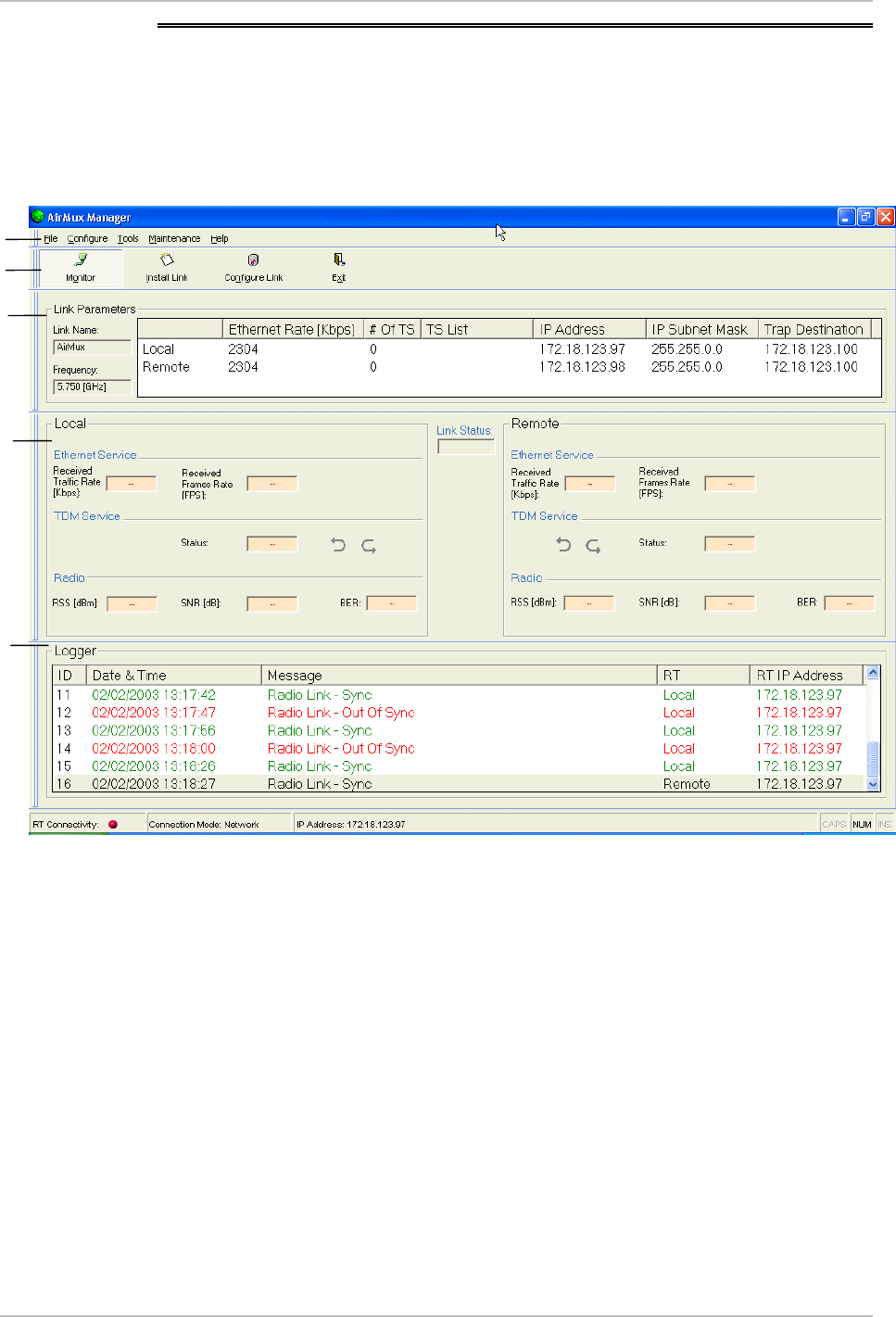
AirMux-104 Installation and Operation Manual Chapter 4 Operation
Managing AirMux-104 4-3
4.3 Managing AirMux-104
Before starting management session, make sure that communication link between
local and remote units exists. The Link Status indication bar in the middle of the
Main menu must be green, Radio Link - Sync message appears in the alarm logger
(see Figure 4-2).
Figure 4-2. Main Menu, Wireless Link is Active
The AirMux Manager Main menu consists of the following elements:
• Toolbar – includes buttons serving for:
Connecting and disconnecting wireless (radio) link (Monitor button)
Performing preliminary configuration of the system (Install Link button)
Changing configuration parameters of operating wireless link, assigning text
files for storing alarms, statistics and configuration data (Configure Link
button)
Exiting AirMux Manager (Exit button)
• Menu bar – functions are identical to those of the toolbar.
• Link Parameters – summarizes information on the radio frequency, IP
bandwidth, number of assigned E1 timeslots, and IP details of the local and
remote AirMux-104 units.
Menu Bar
Toolbar
Link
Parameters
Local and
Remote
Statistics
A
larm
Logger

Chapter 4 Operation AirMux-104 Installation and Operation Manual
4-4 Managing AirMux-104
• Local and Remote Statistics – monitor traffic between local and remote devices
and collect following statistics:
Local/remote received traffic rate (in kbps)
Local/remote received frames rate (in fps)
Radio link status
E1 link status
Radio signal strength (in dBm)
Signal-to-noise ratio (in dB)
Bit error rate.
• Alarm logger – stores alarms generated by local and remote units.
Changing Configuration Parameters
AirMux-104 management software allows you to change configuration parameters
of the radio link between two units, as well as parameters of their SNMP agents. In
addition, you save your parameters in a form of TXT file.
AirMux-104 restarts automatically in order to put configuration changes into effect.
Before starting configuration procedure, make sure that the current configuration
parameters of the local and remote appear in the Link Parameters display. If this
data is not available, you must refresh the display.
To display local and remote unit current parameters:
1. Click on Local or Remote in the Link Parameters display to select a local or
remote AirMux-104.
2. Right-click on selected unit, and select Refresh on the shortcut menu.
The Link Parameters displays IP bandwidth, number of assigned E1
timeslots, and IP details of the selected unit.
Selecting Communication Method
To change communication method:
1. In the Tools menu, select Preferences.
The Communication Preferences dialog box appears (see Figure 4-3).
2. In the Communication Preferences dialog box, select Local (Point to Point) or
Network:
Local (Point to Point) – direct connection via cross cable
Network – connection via network to a specified IP address.
For the network connection, enter IP address of the RT.
3. Click OK to finish communication method selection.
Note
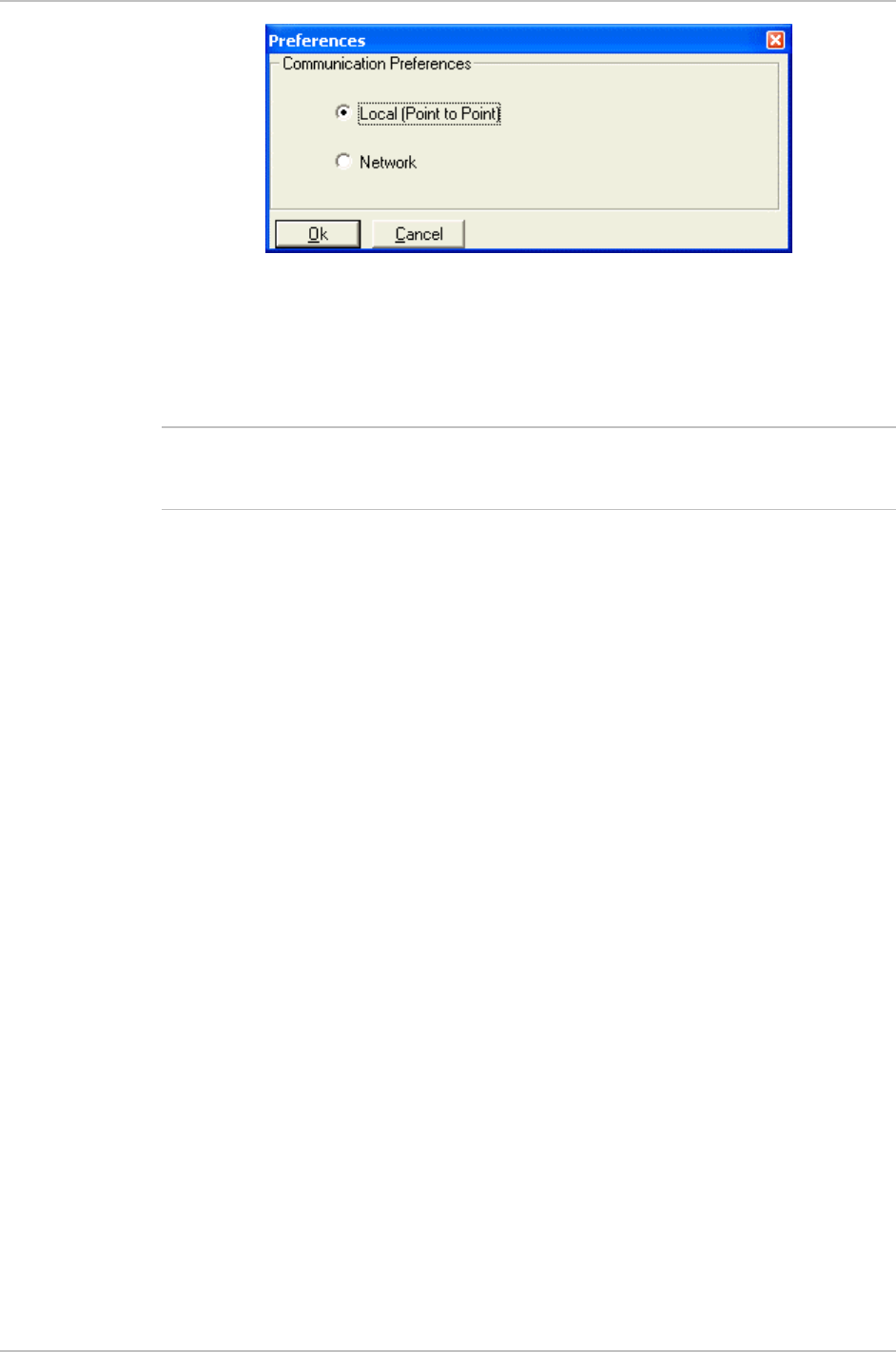
AirMux-104 Installation and Operation Manual Chapter 4 Operation
Managing AirMux-104 4-5
Figure 4-3. Communication Preferences Dialog Box
Selecting Configuration Parameters
You can set the AirMux-104 configuration parameters via Configure Link dialog
box.
AirMux Manager also provides the Configure RT dialog box (Configure > Configure
RT), which is used to configure only the local AirMux-104 unit (the one that is
connected to the management station).
To change link configuration parameters:
1. In the Main menu, click Configure Link.
The Configure Link dialog box appears (see Figure 4-4).
2. In the Configure Link dialog box, click the Radio tab and enter a new link
name, and/or radio channel value, if necessary.
3. Click the IP tab, and enter new IP parameters of the local and/or remote
devices, if necessary.
4. Click the Services tab, and change Ethernet and/or E1 parameters, if
necessary.
5. Once you finish changing configuration parameters, click Apply.
Both AirMux-104s are automatically reset (initially remote unit, then the
local one).
Note
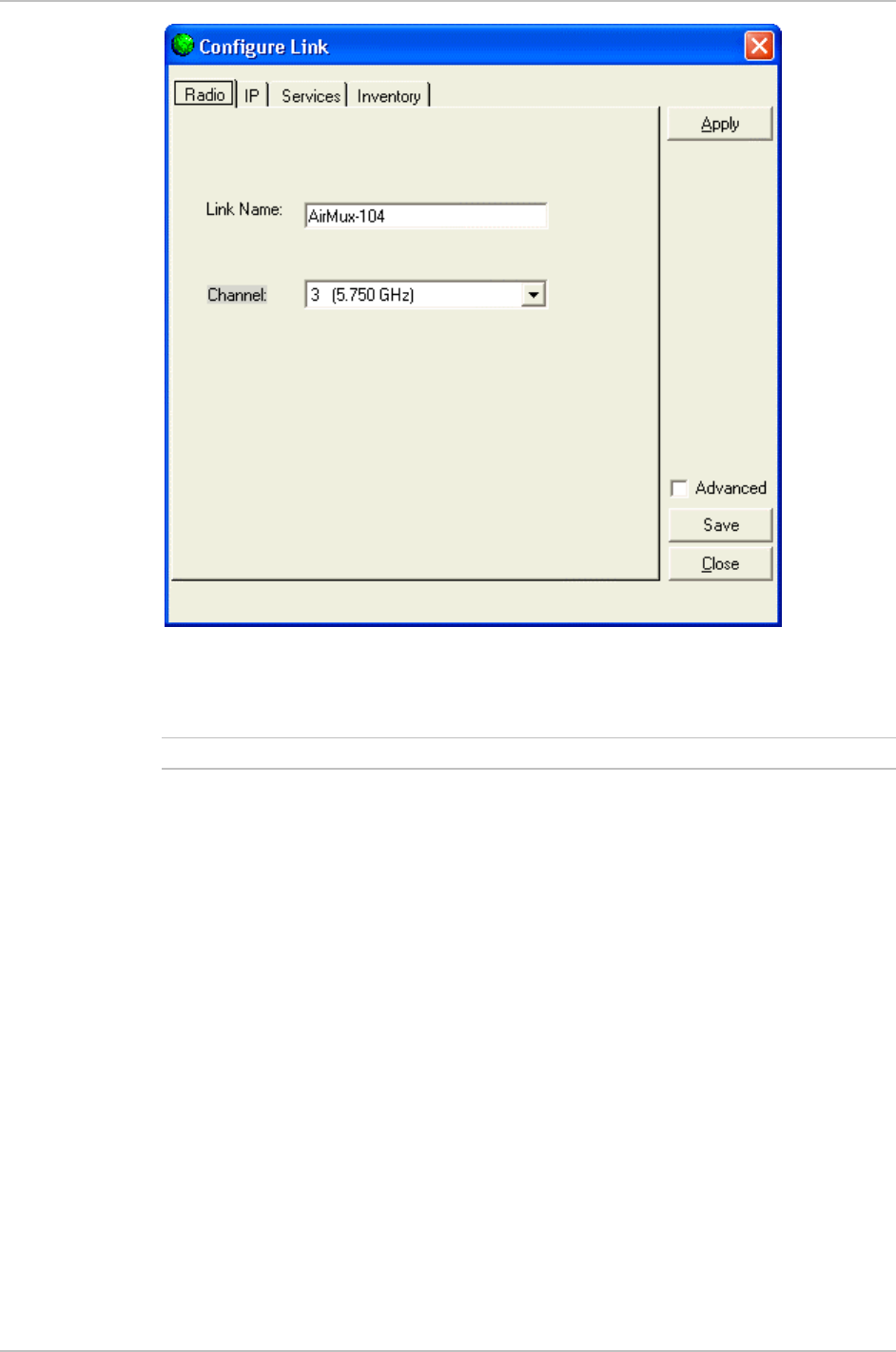
Chapter 4 Operation AirMux-104 Installation and Operation Manual
4-6 Managing AirMux-104
Figure 4-4. Configure Dialog Box
Resetting AirMux-104
In order to maintain communication link, always reset remote AirMux-104 first.
To reset AirMux-104:
1. Click on Local or Remote in the Link Parameters display to select a local or
remote AirMux-104.
2. Right-click on selected unit, and select Reset RT on the shortcut menu.
Local and remote units lose synchronization and Radio Link - Out of Sync
alarm is stored in the alarm logger.
Saving AirMux-104 Configuration in a File
AirMux-104 management software allows you to save configuration parameters of
the local and remote units as a TXT file.
To save AirMux-104 configuration in a file:
1. In the Configure Link dialog box (see Figure 4-4), click Save.
2. In the Save As dialog box, indicate in which folder and under what name
configuration file is to be saved, and click Save.
Note
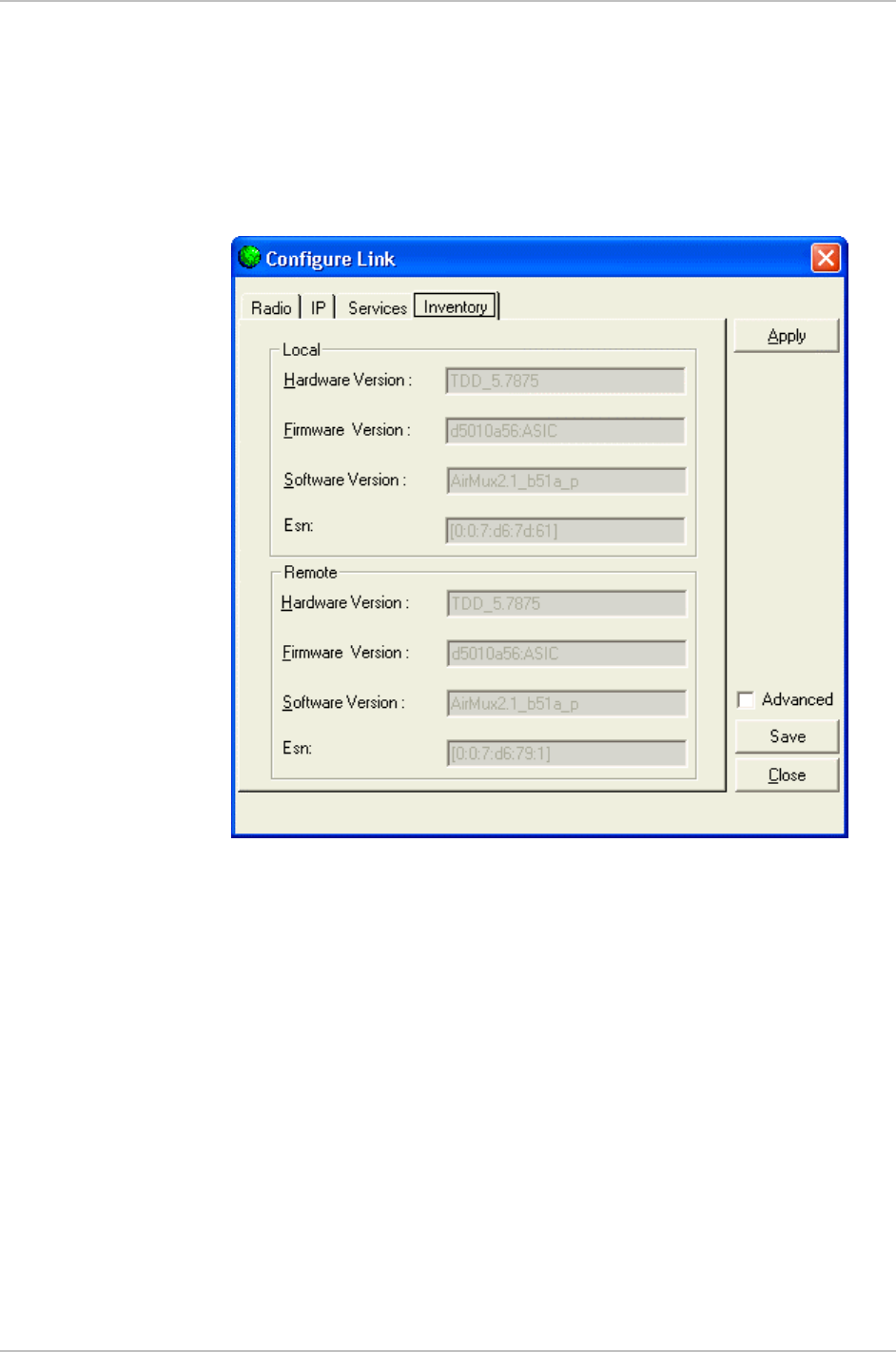
AirMux-104 Installation and Operation Manual Chapter 4 Operation
Managing AirMux-104 4-7
Displaying AirMux-104 Inventory
AirMux-104 inventory includes information on the hardware, firmware and
software versions of the local and remote units.
To display inventory:
• In the Configure Link dialog box, click the Inventory tab.
The local and remote inventory information is displayed (see Figure 4-5).
Figure 4-5. AirMux-104 Inventory

Chapter 4 Operation AirMux-104 Installation and Operation Manual
4-8 Managing AirMux-104

Error Detection 5-1
Chapter 5
Diagnostics and
Troubleshooting
This chapter describes the AirMux-104 diagnostic functions, which include:
• Status indications, alarms, power-up self-test
• Statistics collection
• Diagnostic tests (local and remote loopbacks on E1 link).
5.1 Error Detection
Power-Up Self-Test
AirMux-104 performs a hardware test of the RTCB upon turn-on. This self-test
checks the critical circuit functions of the unit. The RTCB LED indicates results of
the self-test (see Chapter 4 for the LED description).
Alarms
AirMux-104 detects fault conditions of the radio and user links and initiates alarms
to alert the user. The user can save alarm log as a TXT file.
Alarms are displayed in the alarm logger (see Figure 5-1).
Alarm logger includes the following fields:
• Alarm sequential number
• Date and time stamp
• Alarm message
• Alarm source (local or remote RT)
• IP address of the RT that initiated alarm.
Table 5-1. AirMux-104 Alarms and Information Messages
Message Description
Radio Link – Sync Radio link is synchronized
Radio Link – Out Of Sync Radio link lost synchronization
Device Resetting RT was reset due to internal problem
E1 Interface – Normal E1 interface is operating properly
E1 Interface – LOS Loss of Synchronization is reported by E1 interface
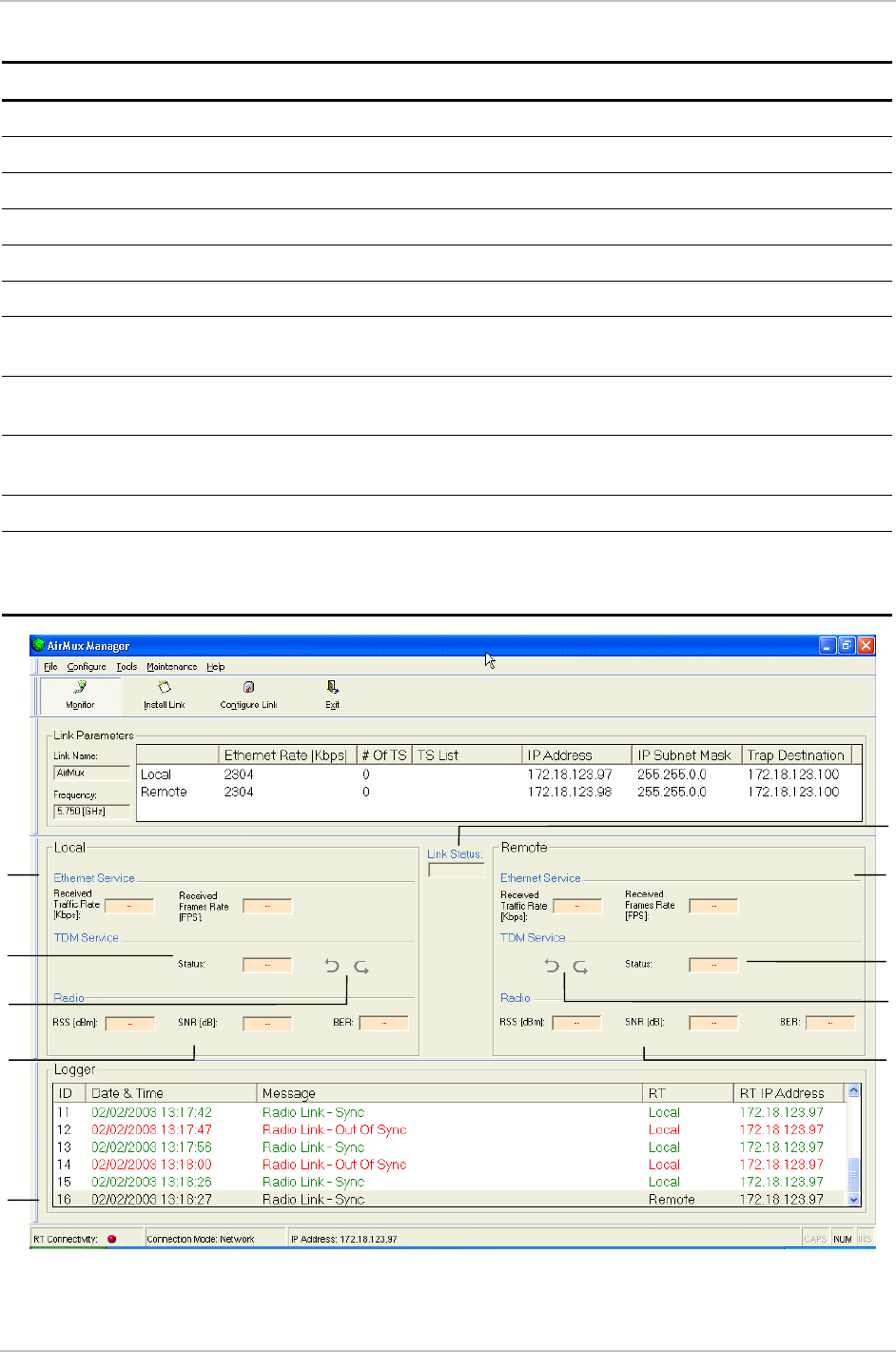
Chapter 5 Diagnostics and Troubleshooting AirMux-104 Installation and Operation Manual
5-2 Error Detection
Table 5-1. AirMux-104 Alarms and Information Messages (Cont.)
Message Description
E1 Interface – LOF Loss of Frame alignment is reported by E1 interface
E1 Interface – AIS Alarm Indication Signal is reported by E1 interface
E1 Interface – RAI Remote Alarm Indication is reported by E1 interface
E1 Interface – CRC CRC error was detected at E1 interface
E1 Interface – CRC_E_BIT CRC E-Bit error was detected at E1 interface
E1 Interface – Loopback A loopback is active on E1 interface
Failed to download data to the
remote RT
AirMux-104 failed to download configuration data to the remote RT
Failed to download data to the local
RT
AirMux-104 failed to download configuration data to the local RT
Link Resetting Wireless link was reset from the management station. This alarm is
usually caused by automatic reset after link configuration.
Local RT Resetting The local RT was reset from the management station.
Error loading trap catcher AirMux Manager detected that the SNMP port 162 of the
management station has been already captured by another
application and cannot receive traps.
Figure 5-1. AirMux-104 Alarms and Status Indications
A
larm
Logger
E1 Status
(Local Unit)
Radio Link
Status
Loopback
Status
(Local Unit)
Loopback
Status
(Remote Unit)
E1 Status
(Remote Unit)
Ethernet
Status
(Local Unit)
Ethernet
Status
(Remote Unit)
Radio Status
(Local Unit)
Radio Status
(Remote Unit)
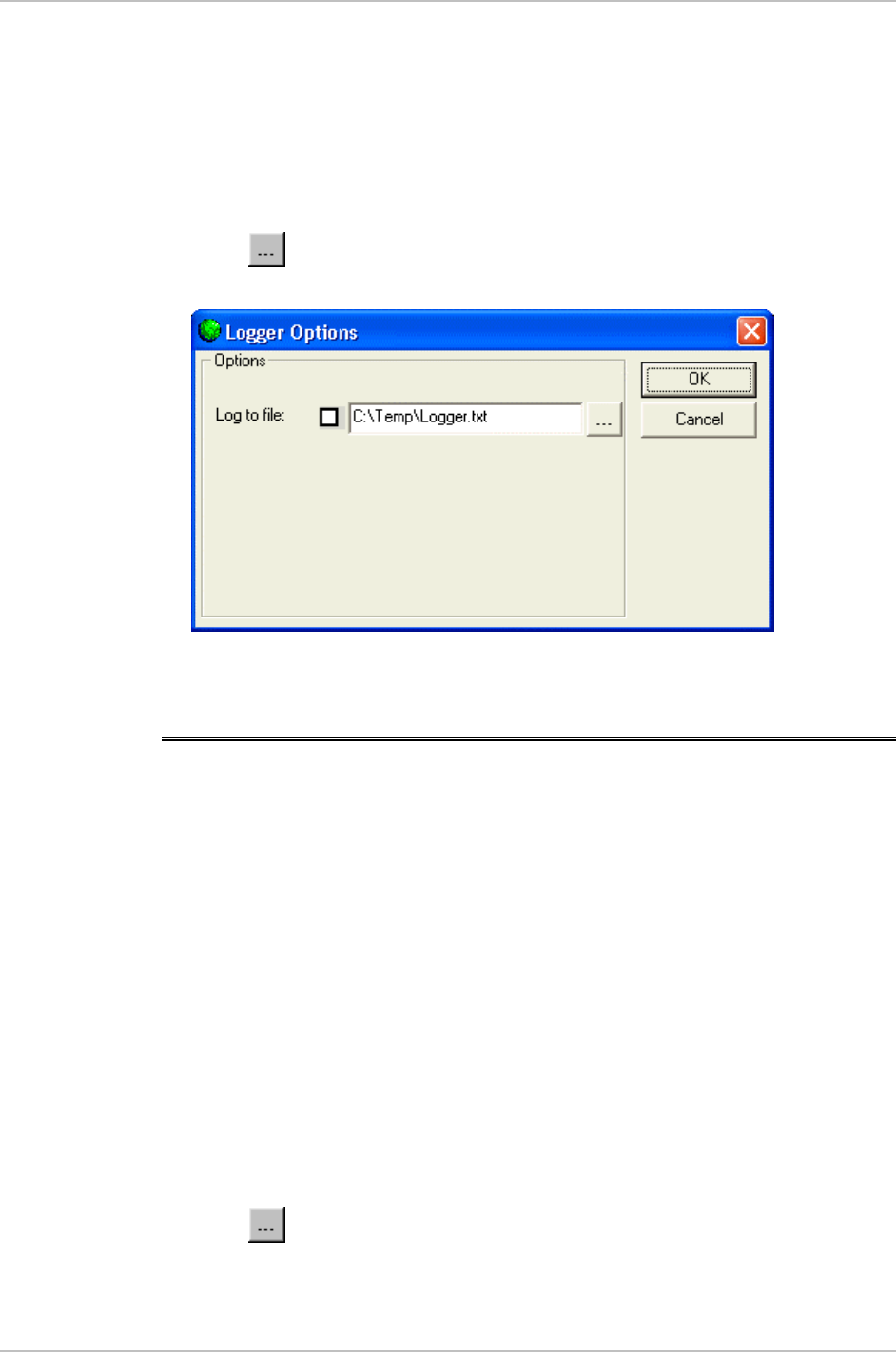
AirMux-104 Installation and Operation Manual Chapter 5 Diagnostics and Troubleshooting
Collecting Statistics 5-3
Saving Alarm Log
Alarm log can be saved as a TXT file. New alarms are automatically added to the
text file, as they enter the alarm logger.
To save alarm log:
1. From the Tools menu, choose Logger Options.
Configure Logger Options dialog box appears (see Figure 5-2).
2. Click button and in the Select File dialog box indicate in which folder and
under what name alarm log file is to be saved, and click Save.
Figure 5-2. Logger Options Dialog Box
5.2 Collecting Statistics
AirMux-104 constantly monitors traffic over the radio link and collects the
following statistics data:
• Local/remote received traffic rate (in kbps)
• Local/remote received frames rate (in fps)
• Radio signal strength (in dBm)
• Signal-to-noise ratio (in dB)
• Bit error rate.
Statistics log can also be saved as a text file.
To save statistics log:
1. From the Tools menu, choose Monitor Options.
Monitor Options dialog box appears (see Figure 5-3).
2. Click button and in the Select File dialog box indicate in which folder and
under what name statistics log file is to be saved, and click Save.
3. In the Interval box, type or select statistics refresh interval (in sec.).
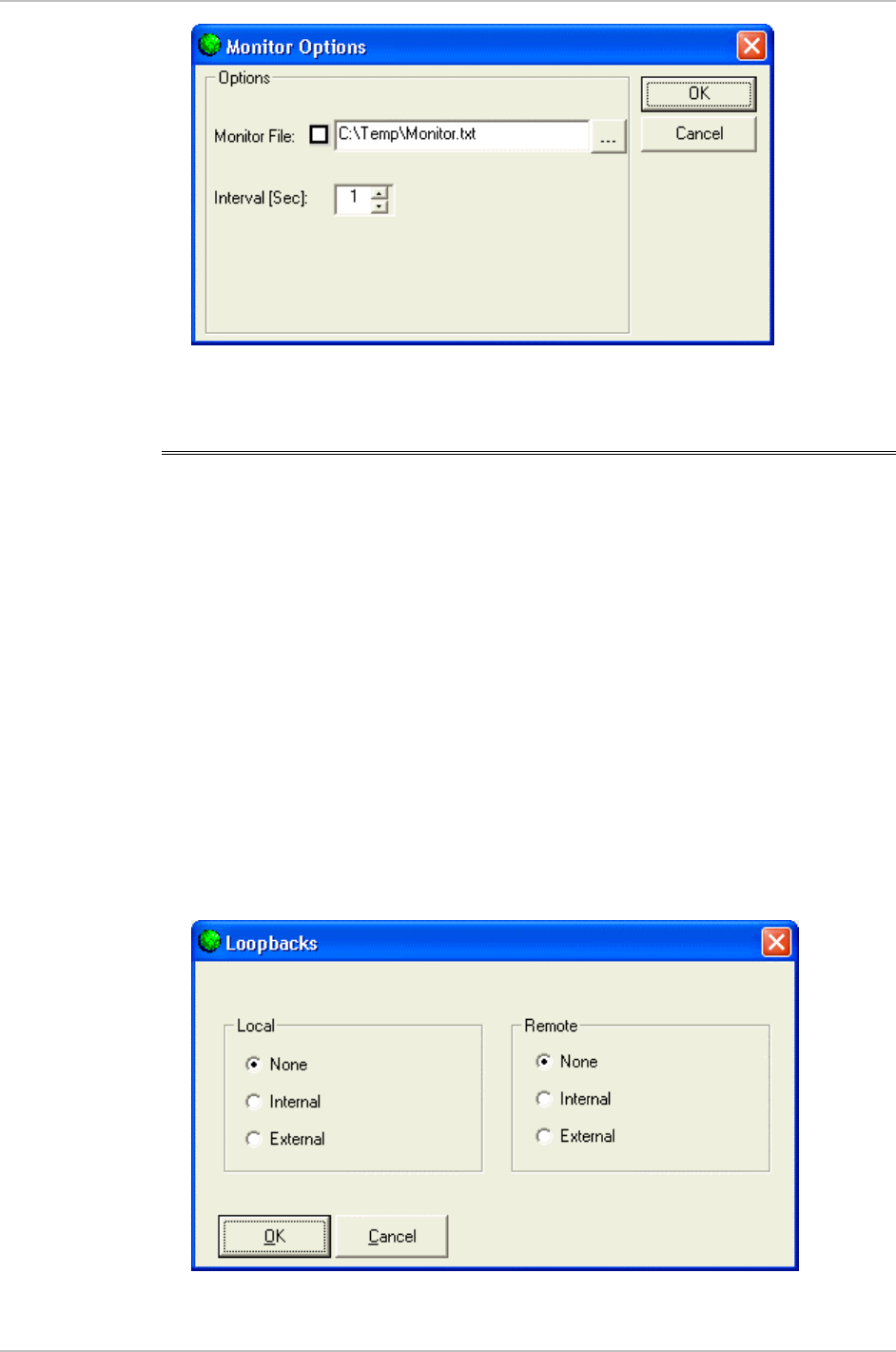
Chapter 5 Diagnostics and Troubleshooting AirMux-104 Installation and Operation Manual
5-4 Running Diagnostic Loopbacks
Figure 5-3. Monitor Options Dialog Box
5.3 Running Diagnostic Loopbacks
AirMux-104 supports activation of the internal and external loopbacks on the local
and remote units.
To activate a loopback:
1. From the Maintenance menu, choose Activate Loopback.
The Loopbacks dialog box appears (see Figure 5-4).
2. From the Loopbacks dialog box, select a loopback that you intend to run, and
click OK.
AirMux-104 activates selected loopback. A loopback status arrow in the
Main menu turns green to indicate an active loopback.
To deactivate a loopback:
• From the Loopbacks dialog box, select None.
A loopback status arrow in the Main menu becomes dimmed.
Figure 5-4. Loopbacks Dialog Box
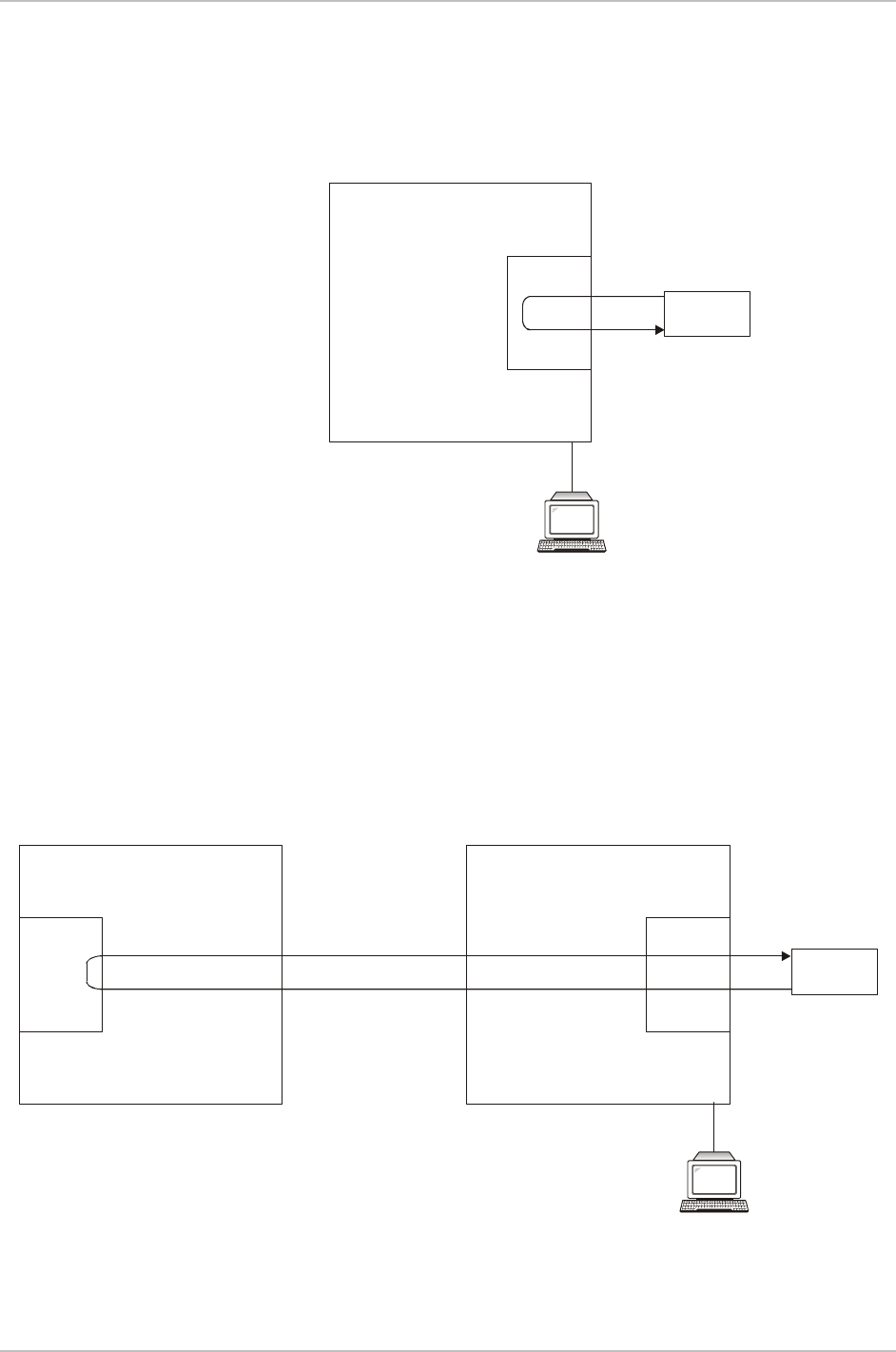
AirMux-104 Installation and Operation Manual Chapter 5 Diagnostics and Troubleshooting
Running Diagnostic Loopbacks 5-5
Local External Loopback
Local AirMux-104 can be set to an external loopback to test the local E1 port and
its connection to the local side user equipment. In this mode, data coming from
the local user equipment is looped back to it (see Figure 5-5). This loopback is
initiated from a management station connected to the local unit.
Tes t i ng
Equipment
Management
Station
E1
Interface
Local RT
Figure 5-5. Local External Loopback
Remote Internal Loopback
Remote AirMux-104 can be set to an internal loopback to test connection
between the local and remote units, the local E1 port and its connection to the
local side user equipment. In this mode, data coming from the local AirMux-104 is
looped back to it (see Figure 5-6). This loopback is initiated from a management
station connected to the local unit.
Management
Station
E1
Interface
E1
Interface
Tes t i ng
Equipment
Remote RT Local RT
Figure 5-6. Remote Internal Loopback
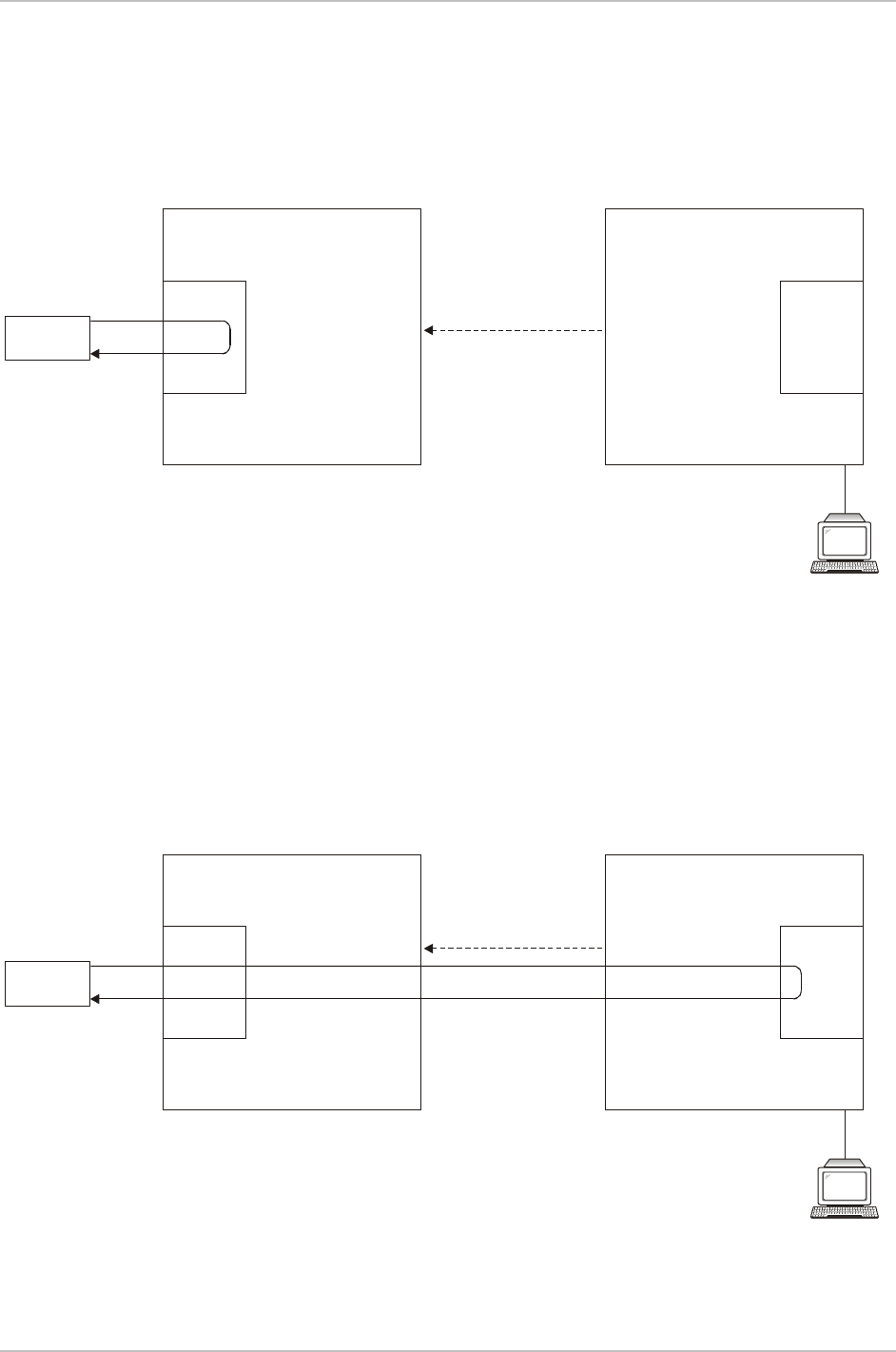
Chapter 5 Diagnostics and Troubleshooting AirMux-104 Installation and Operation Manual
5-6 Running Diagnostic Loopbacks
Remote External Loopback
Remote AirMux-104 can be set to an external loopback to test the remote E1 port
and its connection to the remote side user equipment. In this mode, data coming
from the remote user equipment is looped back to it (see Figure 5-7). This
loopback is initiated by an inband command sent from a management station
connected to the local unit.
Testi ng
Equipment
Management
Station
E1
Interface
E1
Interface
Local RT
Inband Loopback
Activation Command
Remote RT
Figure 5-7. Remote External Loopback
Local Internal Loopback
Local AirMux-104 can be set to close an internal loopback to test connection
between the local and remote units, remote E1 port and its connection to the
remote side user equipment. In this mode, data coming from the remote user
equipment is looped back to it (see Figure 5-8). This loopback is initiated by an
inband command sent from a management station connected to the local unit.
Testi ng
Equipment
Management
Station
E1
Interface
E1
Interface
Local RT
Inband Loopback
Activation Command
Remote RT
Figure 5-8. Local Internal Loopback
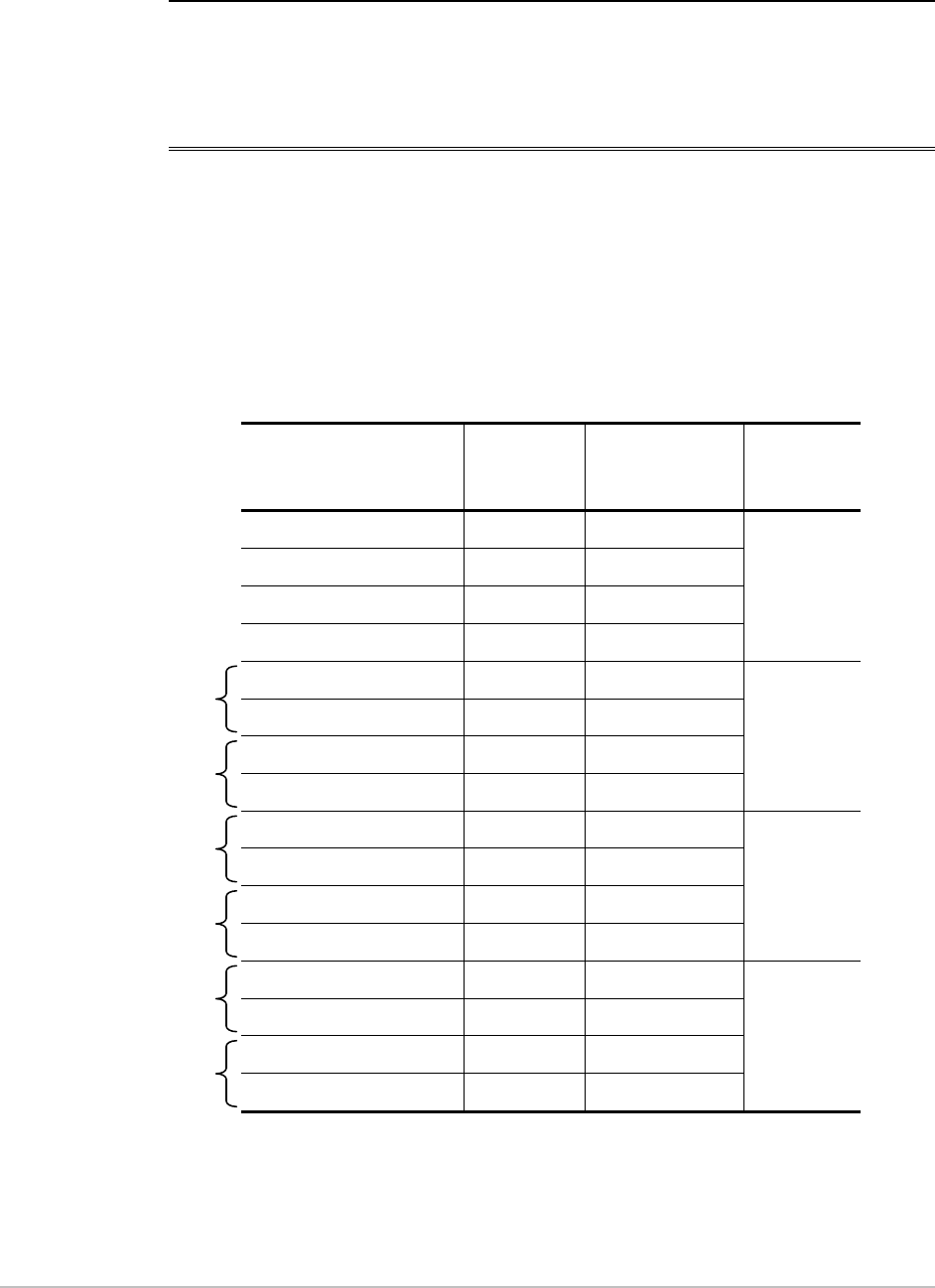
RT Cable A-1
Appendix A
Wiring Specifications
A.1 RT Cable
The RT cable is 100Ω double-shielded data and power supply cable manufactured
by Teldor Wires and Cables Ltd. (http://www.teldor.com). The cable contains six
individually shielded twisted pairs and four power supply wires.
The RT cable terminates in 16-pin Krone-type (RT side) and DB-25 male (RTCB
side) connectors. Table A-1 describes connector pinouts.
Table A-1. RT Cable Connector Pinouts
RTCB Connector Pin
(DB-25)
Wire
Color
RT Connector
Pin
(16-pin)
Function
13 Red/white 1
25 Red/yellow 2
23 Black 3
10 Black 4
Power
20 Blue 5
Twisted 7 White 6
21 Red 7
Twisted 8 White 8
E1
5 Orange 9
Twisted 18 White 10
4 Green 11
Twisted 17 White 12
N.C.
14 Brown 13
Twisted 15 White 14
2 Gray 15
Twisted 1 White 16
Ethernet
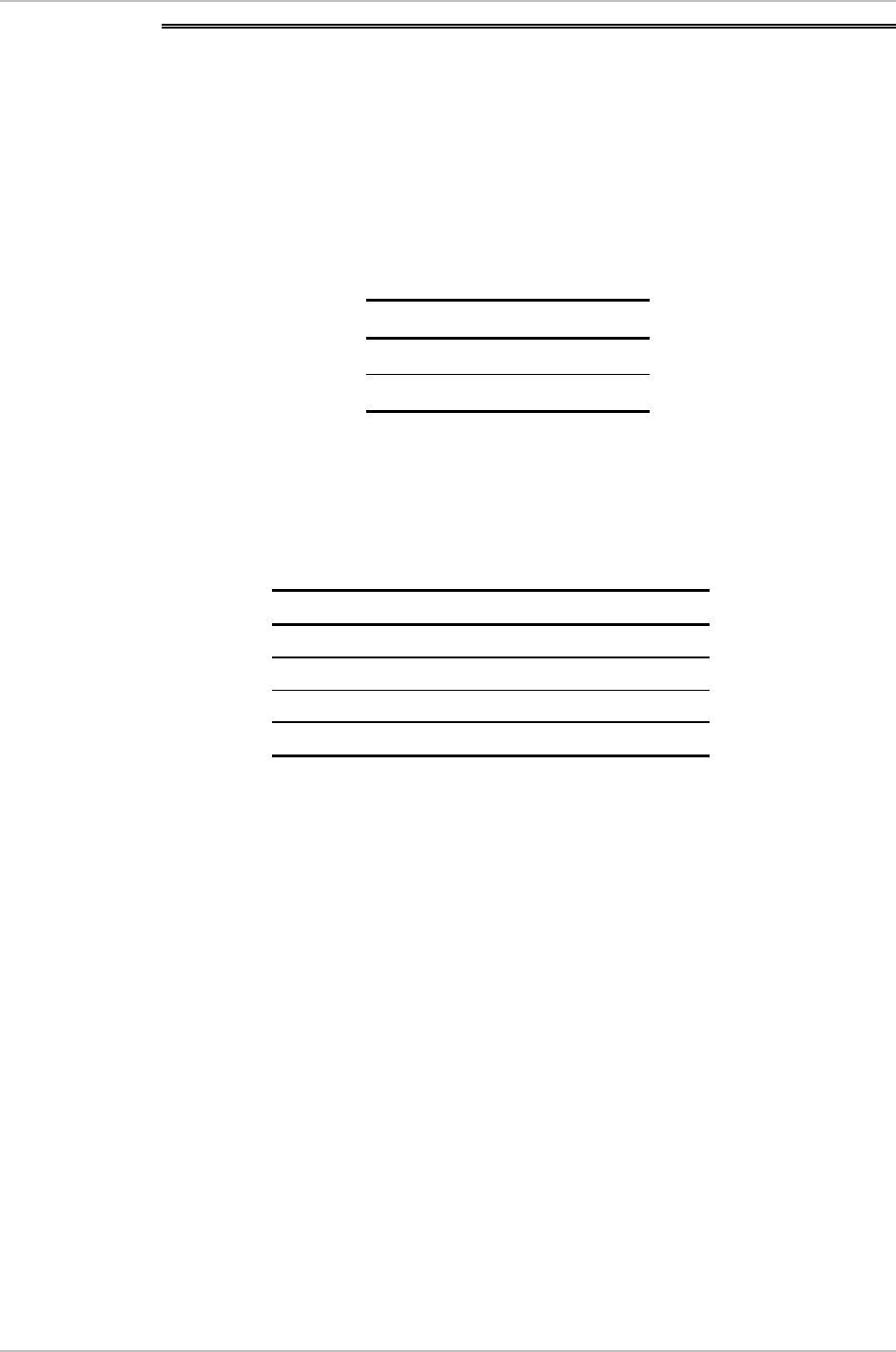
Appendix A Wiring Specifications AirMux-104 Installation and Operation Manual
A-2 User Port Connectors
A.2 User Port Connectors
The RTCB includes ports for connecting E1 and Fast Ethernet user devices.
E1 Port
E1 interface terminates in an 8-pin RJ-45 balanced connector, wired in accordance
to Table A-2.
Table A-2. E1 Connector Pinout
Pin Function
1, 2 Receive (input)
4, 5 Transmit (output)
Fast Ethernet Port
Fast Ethernet interface terminates in an 8-pin RJ-45 connector, wired in
accordance to Table A-3.
Table A-3. Fast Ethernet Connector Pinout
Pin Signal Function
1 TD (+) Transmit Data (positive)
2 TD (-) Transmit Data (negative)
3 RD (+) Receive Data (positive)
6 RD (-) Receive Data (negative)
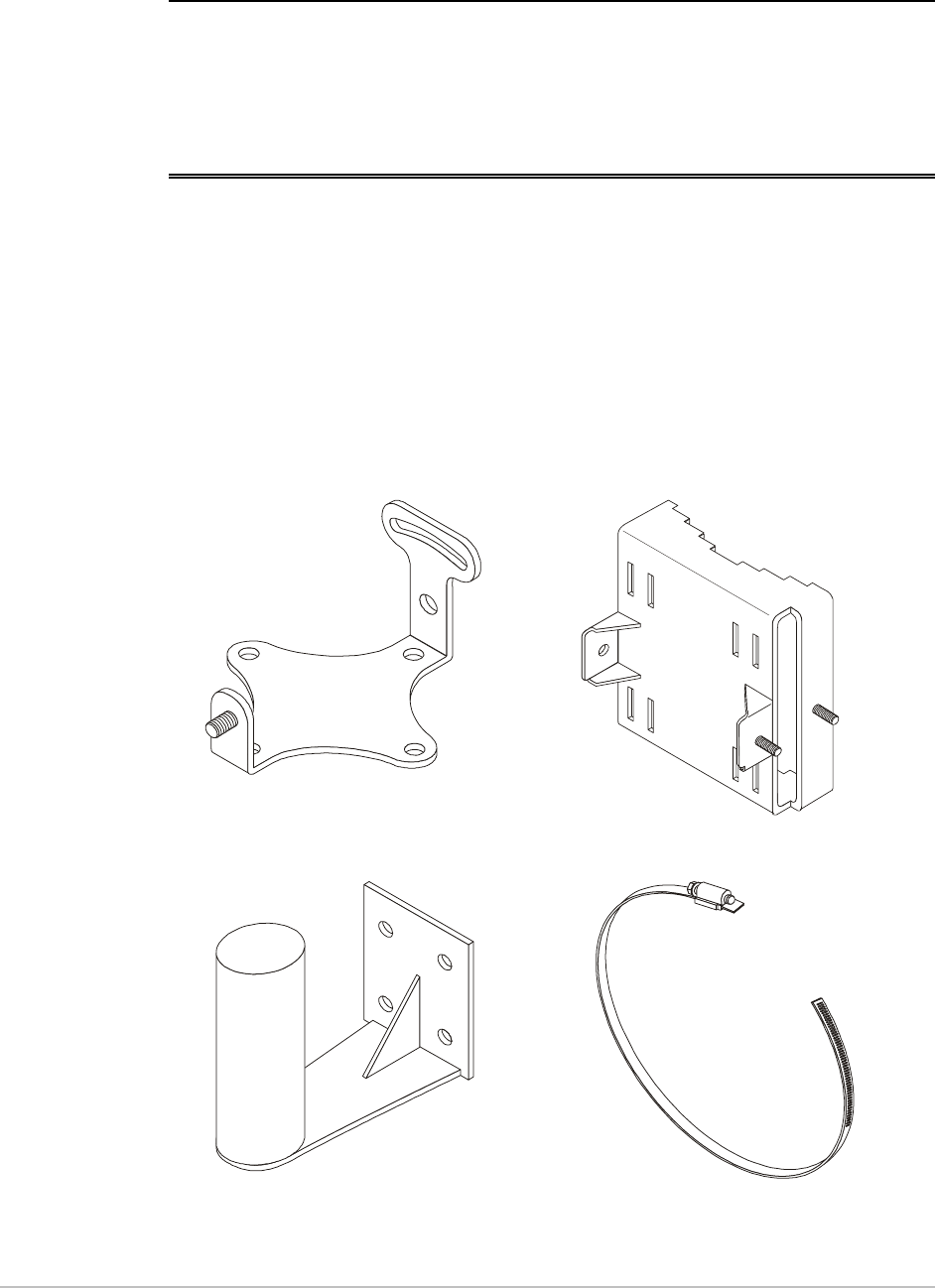
Mounting Kit Contents B-1
Appendix B
Mast and Wall Installation
RT units can be installed on masts or walls.
B.1 Mounting Kit Contents
The RT mounting kit includes the following items:
• One mounting plate (see Figure B-1)
• One pivoting bracket (see Figure B-2)
• One extension arm for wall installation (see Figure B-3)
• Two metal strap clamps (see Figure B-4)
• Four bolts with locking washers
• Three hex nuts with plastic inserts.
Figure B-1. Mounting Plate Figure B-2. Pivoting Bracket
Figure B-3. Extension Arm Figure B-4. Metal Strap Clamp
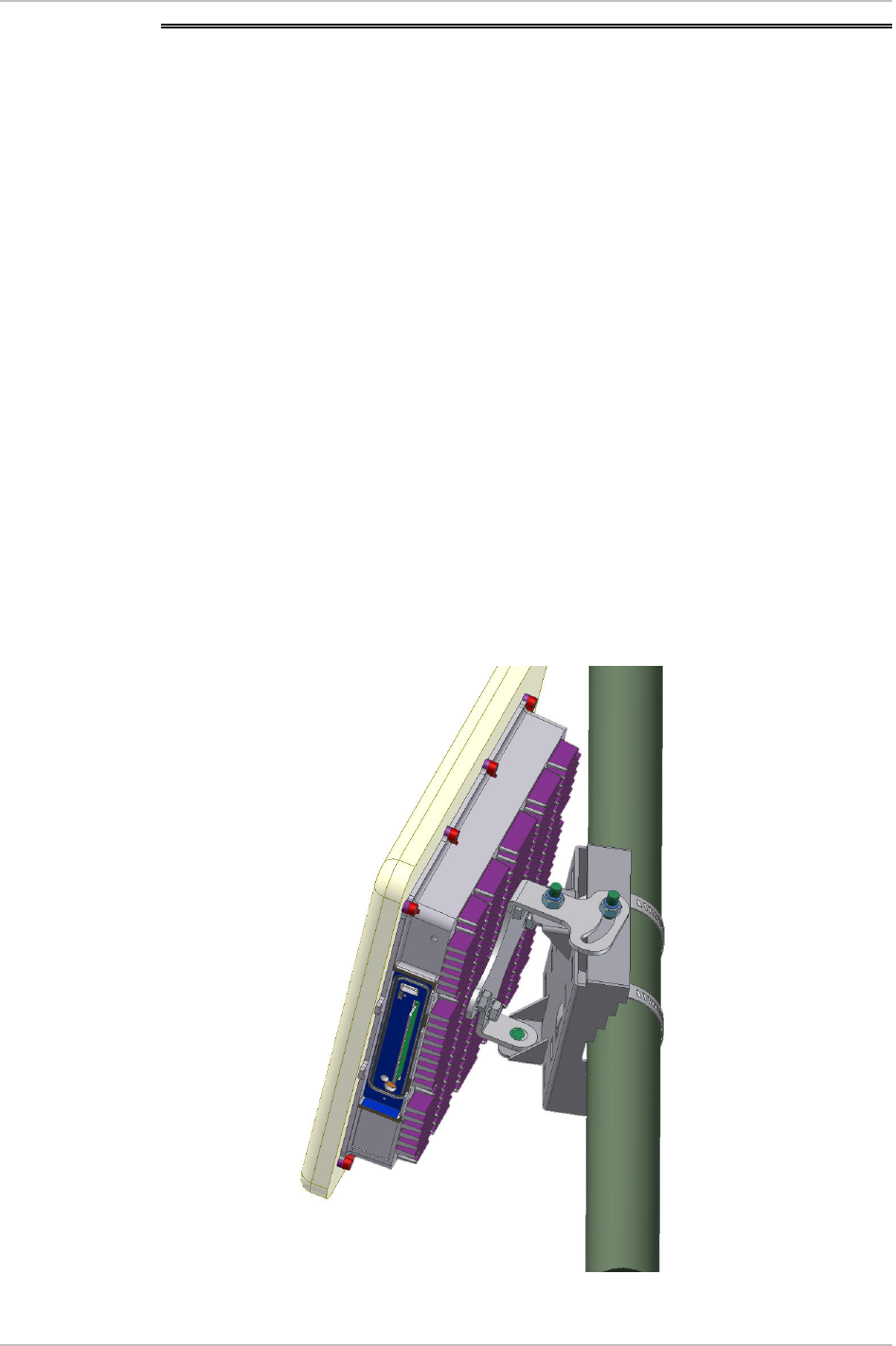
Appendix B Mast and Wall Installation AirMux-104 Installation and Operation Manual
B-2 Mounting AirMux-104 on a Mast
B.2 Mounting AirMux-104 on a Mast
The kit allows you to mount the RT on masts, whose diameter is between 5 cm
(1.9 in) and 8 cm (2.3 in).
To install the RT on the mast:
1. Insert both strap clamps through the vertical slots in the pivoting bracket. Make
sure to use the slots that match the mast diameter.
2. Attach the pivoting bracket assembly to the mast using the strap clamps, but do
not completely tighten the strap clamps yet.
3. Fasten the mounting plate to the rear of the RT, using the four bolts and
locking washers. Make sure that the curved slot of the mounting plate is facing
the two-bolt side of the pivoting bracket.
4. Attach the RT assembly to the pivoting bracket on the mast, so that:
The two bolts on the pivoting bracket enter the hole and curved slot in the
mounting plate.
The mounting plate bolt enters the hole in the pivoting bracket.
5. Attach the three hex nuts, but do not tighten them.
6. Align the RTS, as explained in Mounting and Aligning the RT in Chapter 3.
7. When the alignment process is completed, permanently fasten the RT to the
mast by tightening the hex nuts and the strap clamps.
Figure B-5. RT Mounted on a Mast

AirMux-104 Installation and Operation Manual Appendix B Mast and Wall Installation
Mounting AirMux-104 on a Wall B-3
B.3 Mounting AirMux-104 on a Wall
The mounting kit includes an extension arm for the wall installation.
To attach the RT to the mast:
1. Fasten the extension arm to the wall by using four screws (not included).
2. Attach the RT to the extension arm, as explained in the mast mounting
instructions above.

Appendix B Mast and Wall Installation AirMux-104 Installation and Operation Manual
B-4 Mounting AirMux-104 on a Wall

24 Raoul Wallenberg St., Tel Aviv 69719, Israel
Tel: +972-3-6458181, Fax: +972-3-6483331, +972-3-6498250
E-mail: , Web site:
Customer Response Form
RAD Data Communications would like your help in improving its product documentation.
Please complete and return this form by mail or by fax or send us an e-mail with your
comments.
Thank you for your assistance!
Manual Name: ______________________________________________________________
Publication Number: __________________________________________________________
Please grade the manual according to the following factors:
Excellent Good Fair Poor Very Poor
Installation instructions ❒ ❒ ❒ ❒ ❒
Operating instructions ❒ ❒ ❒ ❒ ❒
Manual organization ❒ ❒ ❒ ❒ ❒
Illustrations ❒ ❒ ❒ ❒ ❒
The manual as a whole ❒ ❒ ❒ ❒ ❒
What did you like about the manual?
___________________________________________________________________________
___________________________________________________________________________
___________________________________________________________________________
___________________________________________________________________________
___________________________________________________________________________
erika_y@rad.co.il
www.rad.com
A
irMux-104
193-200-03/03
Error Report
Type of Error(s) ❒ Incompatibility with product
or Problem(s): ❒ Difficulty in understanding text
❒ Regulatory information (Safety, Compliance, Warnings, etc.)
❒ Difficulty in finding needed information
❒ Missing information
❒ Illogical flow of information
❒ Style (spelling, grammar, references, etc.)
❒ Appearance
❒ Other _________
Please list the exact page numbers with the error(s), detail the errors you found (information missing,
unclear or inadequately explained, etc.) and attach the page to your fax, if necessary.
_________________________________________________________________________________________
_________________________________________________________________________________________
_________________________________________________________________________________________
_________________________________________________________________________________________
Please add any comments or suggestions you may have.
_________________________________________________________________________________________
_________________________________________________________________________________________
_________________________________________________________________________________________
You are: ❒ Distributor
❒ End user
❒ VAR
❒ Other ________________________
Who is your distributor? _______________________________
Your name and company: ___________________________________________________________
Job title: __________________________________________________________________________
Address: __________________________________________________________________________
Direct telephone number and extension: _______________________________________________
Fax number: ______________________________________________________________________
E-mail: _____________________________________________________________________
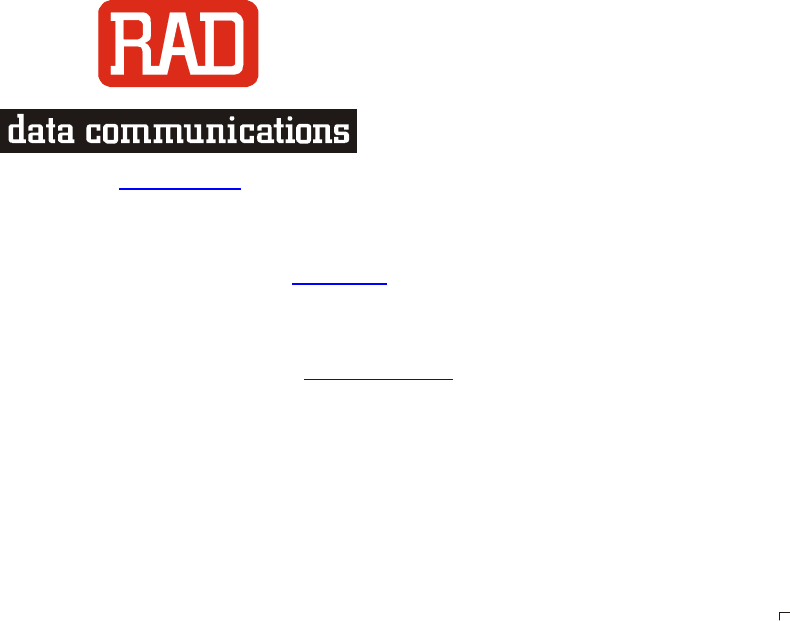
900 Corporate Drive, Mahwah, N.J. 07430, Tel: (201) 529-1100
24 Raoul Wallenberg Street, Tel Aviv 69719, Israel, Tel: 972-3-6458181
U.S. HEADQUARTERS:
INTERNATIONAL HEADQUARTERS:
Publication No. 193-200-03/03
www.rad.com
Fax: 972-3-6498250, 972-3-6474436, Email: rad@rad.co.il
Toll Free: 1-800-444-7234, Fax: (201) 529-5777, Email: market@radusa.com